






































































































































































































































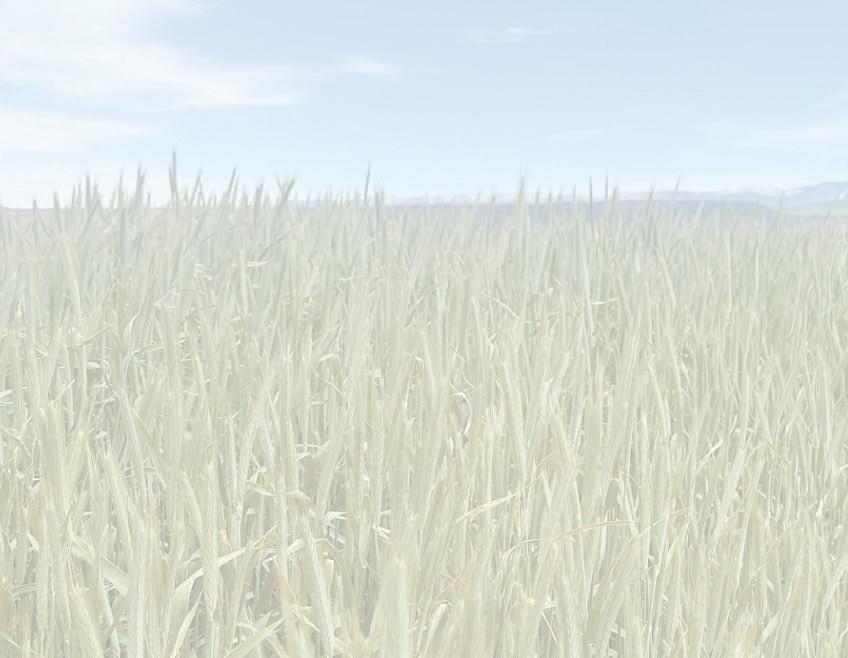
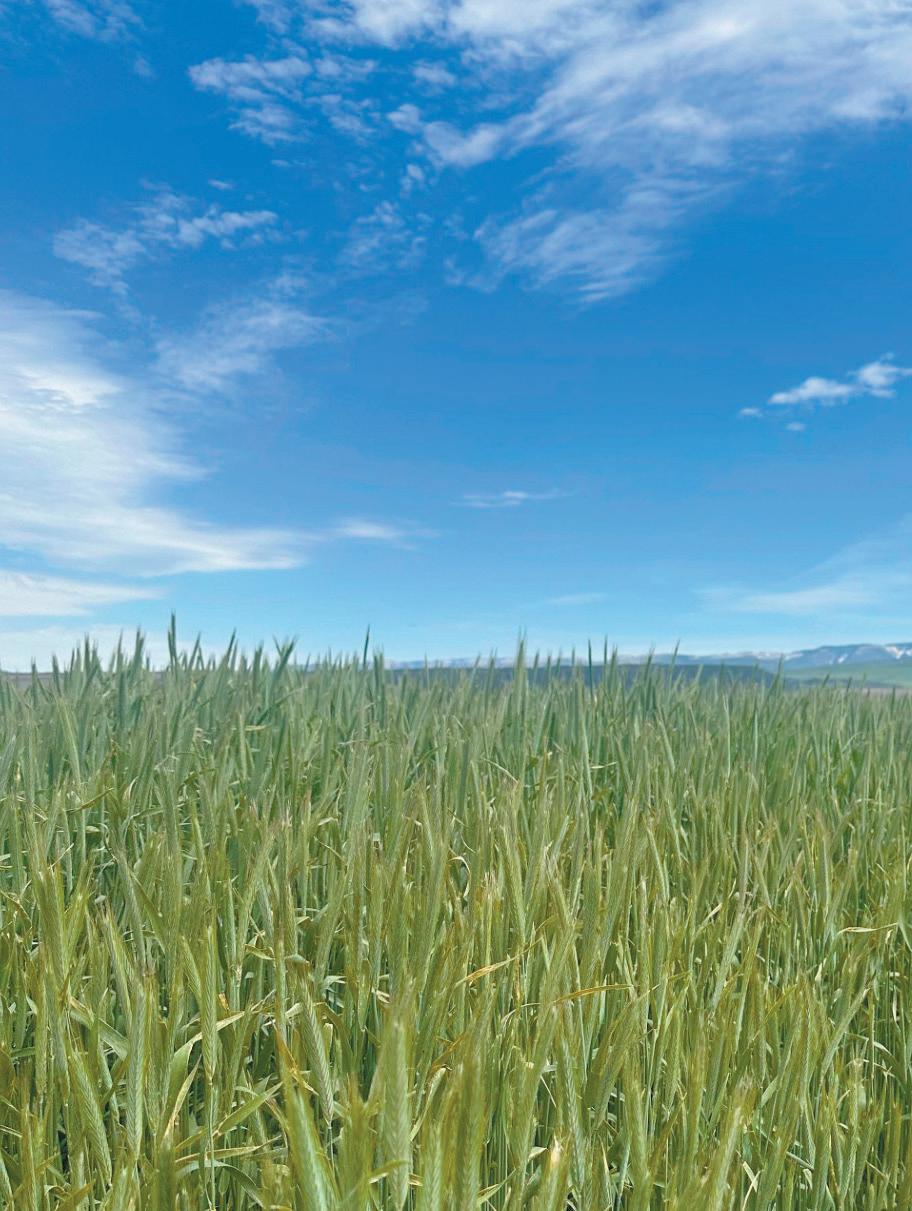
As we enter the second year of Montana Farmers Union Magazine, we are struck by the network of knowledge and expertise that make this project not only possible but worthwhile and meaningful to you.
No venture survives without hard work, but that effort sure is easier to make knowing you’ve got a support network willing to pitch in resources, knowledge, and feedback.
MFU understands that family farmers and ranchers are unstoppable when we join together. Much like the network that makes the Magazine possible, MFU networks around the state are making communities stronger, including meat processing facilities; networking opportunities; youth Day Camps; Lunch & Learn and Ladies Who Ag programming; funding for FFA, 4-H and community projects; scholarships; and more.
This time last summer, we were writing about Pam Gerwe and Purple Frog Gardens in Whitefish. In the midst of greenhouses and rows of vegetables and berries, sits a rhubarb patch that began with one plant, given to Pam by her neighbor. The neighbor didn’t just give Pam the plant; she gave her the knowledge to keep it alive and thriving.
What rhubarb do you have to share with your neighbor?
Is it an invitation to the pumpkin patch? Is it an afternoon spent teaching them how to pickle their green bean crop? Is it a conversation about how you’re keeping a pest at bay? Is it helping a neighbor with an injured animal? Or is it being vulnerable enough to ask that burning question about direct-to-consumer marketing or cottage food law you’re worried is silly?
In many ways Montana Farmers Union Magazine is a compilation of rhubarb offerings from professionals and members to help answer your questions about agricultural innovation and community vitality. The Magazine also is an extension of Montana Farmers Union’s work to support you through education, legislation, and cooperation and its tireless efforts to make sure you have access to the resources, tools, and knowledge you need to be successful.
In other words, thanks for sharing your rhubarb with other members and MFU to build a statewide network of members passionate about agriculture and rural communities.


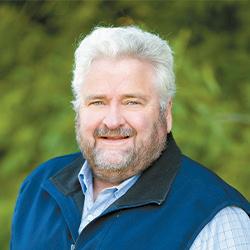
by MFU President Walter Schweitzer
Recently, I joined other National Farmers Union leaders in meetings with the House Ag and Senate Ag committees about each of their versions of the 2024 Farm Bill. Based on those discussions, a tight timeline, and the need for modifications to both versions, I’m not optimistic for the passage of a 2024 Farm Bill but foresee another extension.
The Senate version and the House version of the Farm Bill are strikingly different — and, in the current Congress, “compromise” is a dirty word. Nonetheless, Congress will not allow the Farm Bill to expire because then we would revert to permanent law of the 1949 Farm Act. Price supports included in the 1949 Farm Act would result in taxpayers paying producers higher prices for commodities than the current marketplace. This backstop has forced Congress to act in the past, and I think it will again.
Even though the House version was passed out of committee, most agree it will struggle to pass the full House, with some representatives arguing it was passed only to be used as a political football in the 2024 campaign. The House version favors large corporate farms. It also redirects funding in the Inflation Reduction Act, from voluntary conservation programs, to instead fund programs that benefit the largest farms at the expense of family farms.
Meanwhile, the Senate version leaves in place Inflation Reduction Act funding that fully funds voluntary conservation programs, like CSP, EQIP, ACEP, and RCPP. Historically, these programs were woefully underfunded at levels with only enough funding to cover the cost of 1 of every 4 applications.
The Senate version establishes a Special Investigator with the powers of the DOJ to enforce the rules of the Packers and Stockyards Act and address the anticompetitive practices of corporate monopolies. Including this in the farm bill would make Senator Tester’s proposed Special Investigator bill as well as the USDA’s “Chief Competition Officer” created by the Biden administration permanent.
The Senate version solidifies in law a USDA Cattle Contract Library, which is a good first step in restoring price transparency to the livestock market. Shedding daylight on the secret contracts between corporate feeders and corporate packers is essential for a competitive marketplace, but it still requires cash trade before slaughter to determine the basis in the contracts. The Senate version further establishes standards for voluntary U.S. origin labeling claims for Food Safety Inspection Service products. Including this in the Farm Bill protects the current rules in future administrations by codifying President Biden’s rule that Product of USA can only be used on products born, raised, and processed in the USA.
Unfortunately, the Senate version also includes the A Plus Act. This will weaken the Packers and Stockyards Act by allowing auction yard owners to own a packing plant of up to 2,000 head per day of cattle and/or 10,000 head of hogs per day. This is prohibited by the PSA — and should continue to be prohibited. Allowing auction yards to operate large packing plants will aid in the consolidation of livestock auction yards into the hands of few and reduce competition at the expense of the smaller regional yards. Instead, full enforcement of the PSA and requiring cash trade just before slaughter would expand our current livestock auction yards.
There are fewer than 30 days between now and the general election when both the House and Senate are in session. That’s not enough time for proper debate, compromise, and the passage of a Farm Bill that strengthens family farms and ranches. Some are advocating to pass a farm bill now, but Farmers Union is advocating to pass the right farm bill.
Farmers Union believes the best way to predict the future is to create it and that is why we are working to help forge a Farm Bill that will create a strong future for family farmers and ranchers.

MONTANA FARMERS UNION
PO BOX 2447
300 RIVER DRIVE NORTH, STE 1
GREAT FALLS, MT 59403
PHONE: (406) 452-6406
1-800-234-4071
FAX: (406) 727-8216
mfu@montanafarmersunion.com www.montanafarmersunion.com
Board of Directors:
Walter Schweitzer, President
Rollie Schlepp, Vice President, Conrad
Jan Tusick, Secretary/Treasurer, District 6, Ronan
Erik Somerfeld, District 2, Power
Jeff Bangs, At-Large Director, District 1 & 2, Inverness
Tom Clark, District 1, Fort Benton
Brett Dailey, District 4, Jordan
Trent Stoltz, District 5, Pompey’s Pillar
Ben Peterson, At-Large Director, Judith Gap
Sig Rudie, At-Large Director, District 3 & 4, Fairview
Sarah Degn, District 3, Sidney
MFU Staff:
Walter Schweitzer, President
Matt Rains, Chief of Staff
Jan Johnson, Office Mgr., Assistant Secretary/ Treasurer
Kari Kester, Administrative Assistant
Rachel Prevost, Government Affairs Director/ Member Svcs.
Matthew Hauk, Education Director
Heather Wendell, Communications Director
Alice Miller, Press Relations Specialist
Samantha Ferrat, Membership Ambassador
Eleanor Dutton, Membership Ambassador
Carissa McNamara, Membership Ambassador
Mary Jenni, Membership Ambassador
Skylar Williams, Membership Ambassador
Jeri Copenhaver, Membership Ambassador
Jodi Koterba, Education Associate & Ambassador
Copyright © Montana Farmers Union, 2024 MFU Magazine is the official publication of the Farmers Educational and Cooperative Union of America, Montana Division.
MFU reserves the right to reject any advertisements. Membership: $50.00 per year
Montana Farmers Union Magazine is published quarterly.
Layout & Design: Heather Wendell
Copy Editors: Alice Miller, Jan Johnson & Heather Wendell
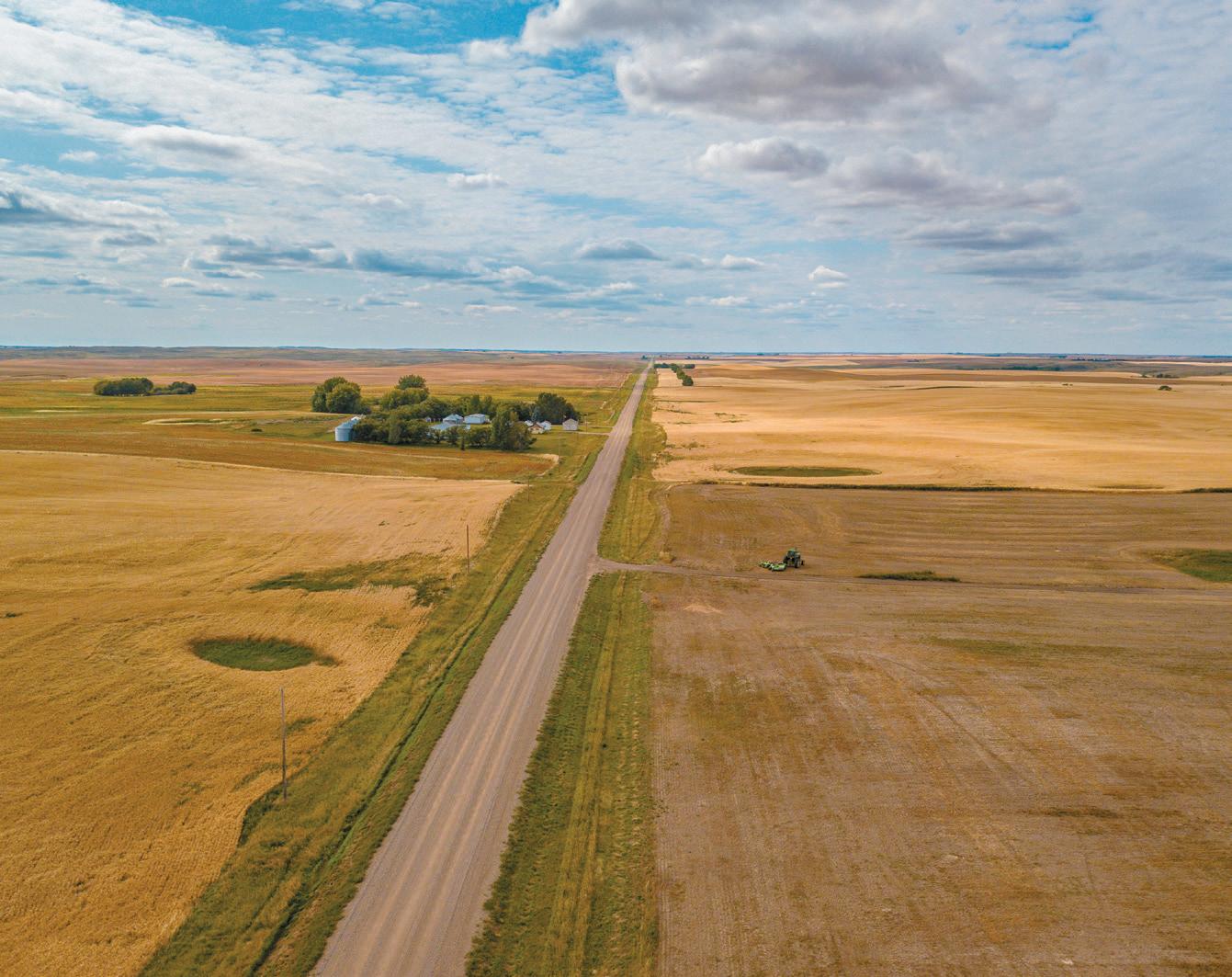

Montana Farmers Union is the oldest & largest family farm organization in the state who represents family farmers & ranchers.


MFU is working for family farms, ranches, rural communities, & supports its members through: strong education programs for both youth and adults, advocating member-driven policies & legislation at the state and federal level, & cooperation through producer-owned co-ops.




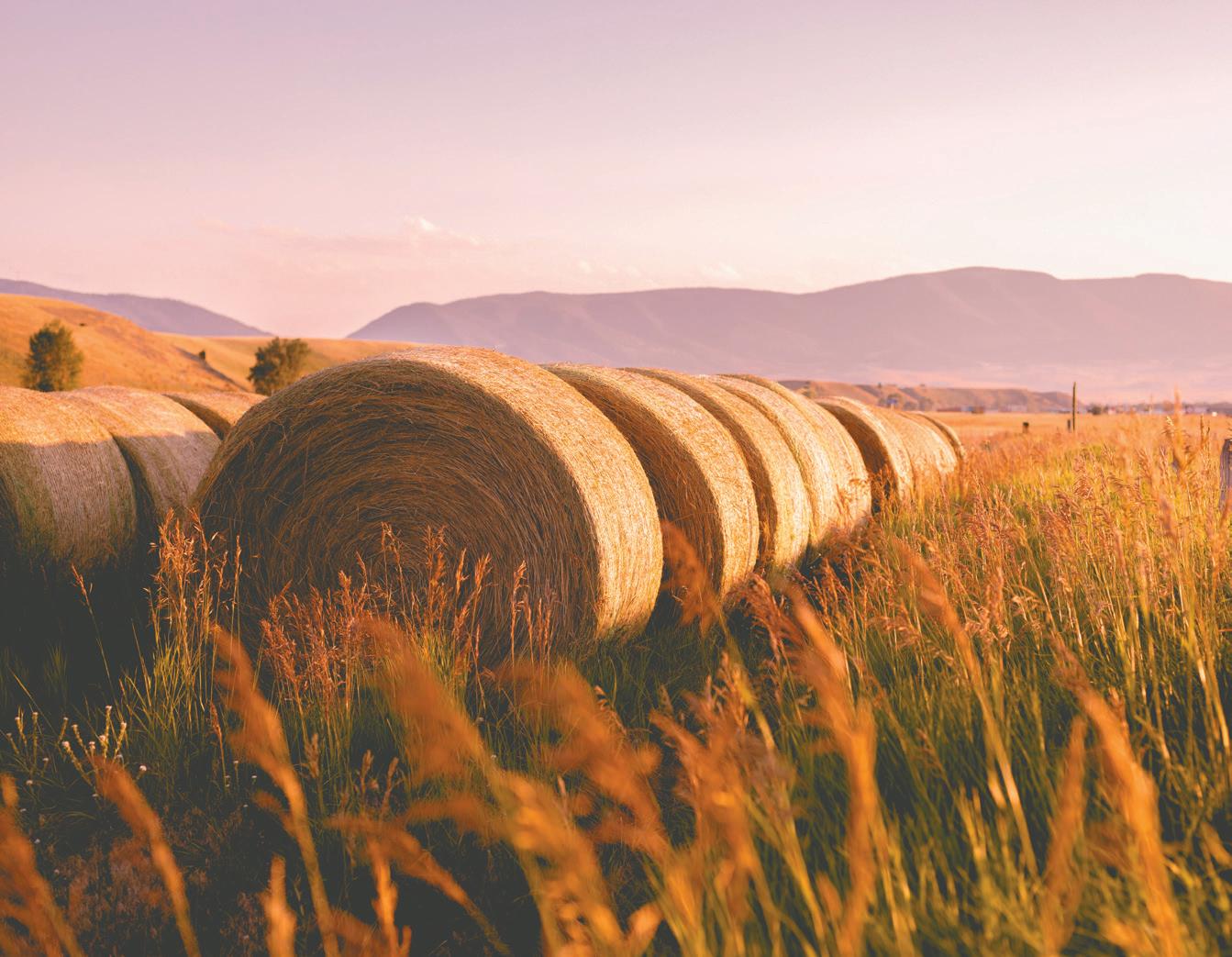
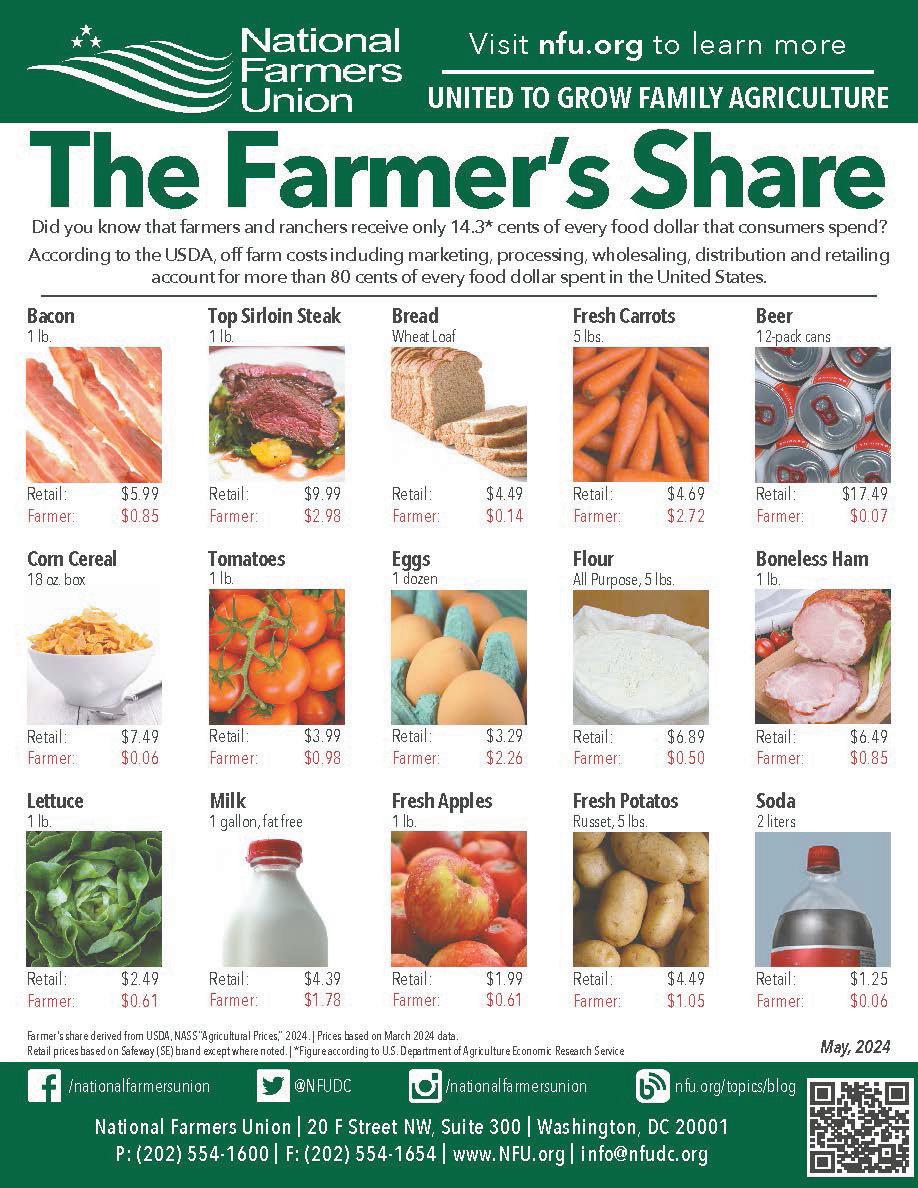
By Mamie Hertel
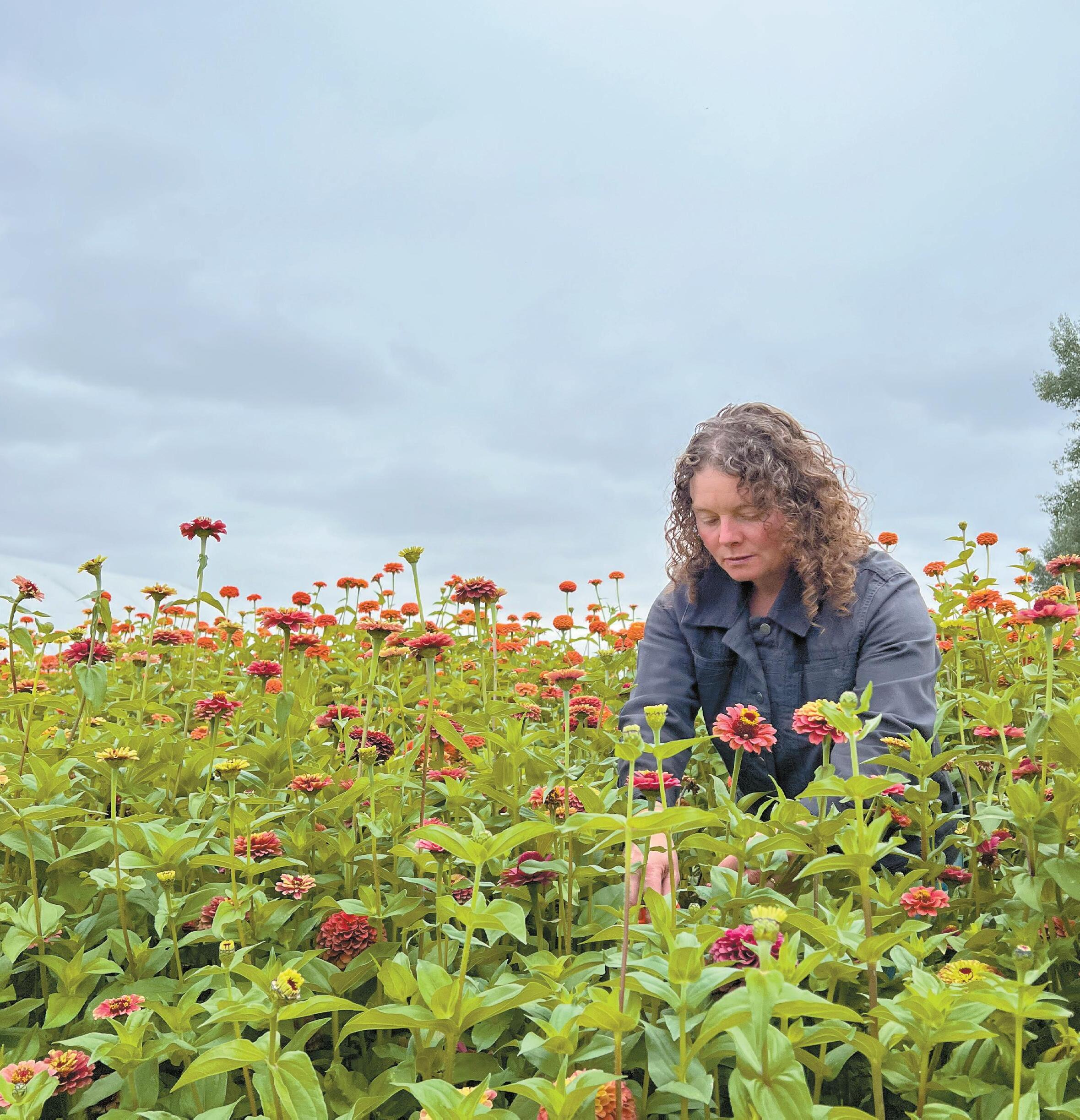

Growing up in Montana with deep agricultural roots, Carah Ronan always felt a strong connection to the land and the rhythms of farm life. Her family’s farming traditions trace back to the fifth and sixth generations, interwoven with the railroad industry that defined much of her childhood in Laurel. This blend of farming and railroading shaped her understanding of hard work and community.
Due to her mom’s and stepfather’s jobs as railroaders, the family moved frequently, living in various states, including Minnesota and Texas. Despite these moves, Montana always felt like home to Ronan. “My childhood was rooted in conventional agriculture. We had gardens because it was a way of life, not a conscious choice,” Ronan said. “This background influenced my life a lot, even though I never initially intended to follow an agricultural path.”
Continued on next page

Today, Ronan has found her place in agriculture through her creative ideas and unique cut-flower operation, Rodi Farm, that has expanded and proved the possibility of growing a business with limited acreage.
Ronan pursued her undergraduate degree at Southern Methodist University in Texas, thanks to the Hunt Leadership Scholarship, which also allowed her to study abroad in Paris. “My education was diverse, but agriculture remained a constant undercurrent in my life,” she said.
After graduating from SMU, Ronan went to Montana State University for graduate school, delving into sustainable farming and environmental practices. During this time, she expanded her skills on two farms, Deep Creek Green in Paradise Valley and Camp Creek Farm outside of Four Corners, where generous mentors helped build the knowledge base essential for her dream of full-time farm life.
In 2021, Ronan and her husband, Zach Didier, who also had farming roots in Minnesota, made the decision to leave their big city life in Fort Worth, Texas, and return to the family farm in Laurel. They moved back alongside her grandmother, focusing on rare and heirloom flowers and vegetables. Their goal at Rodi Farm is to bring local, fresh, long-lasting blooms and food to their community, all while honoring the heritage of the generations of family that came before them. They embrace sustainable, organic growing practices and regenerative agriculture to create a thriving, biodiverse system for future generations.
“For us, the history, heritage, and hard work that comes from working the land is in our blood,” Ronan said. “We both grew up watching family farm. Grandma lived it first-hand: from sugar beets and canola to meat and dairy cattle, poultry, and the ever-present backyard garden blooming with vegetables, flowers, and even giant pumpkins. Canning, drying, preserving, and learning how to use the best of summer’s gifts to last us through the winter.”
Life on Ronan’s farm is demanding and unpredictable. Each day starts early, often at daybreak, and much of her operation is powered by individual labor efforts. “Planting and tending to crops is mostly done by hand, which is labor-intensive but necessary given our scale,” Ronan said. “We face challenges from the weather, pests, and other unforeseen events. We lost over 10,000 tulips to a late frost this year, a significant financial hit.” Despite such setbacks, Ronan loves the resilience and adaptability that farming teaches. It’s a constant cycle of learning and adjusting to the changing environment.
Her farm also includes poultry, primarily for egg production and pest control. Ducks and chickens help manage grasshopper populations, and are crucial for maintaining the farm’s organic certification. Eventually, Ronan hopes to introduce meat birds, but the lack of poultry processing facilities in Montana presents a significant challenge.
Zach Didier, with his mechanical mind and hands, plays a crucial role in the farm’s daily operations. His ability to fix,

create, and orchestrate ensures that everything runs smoothly. “His gift to fix anything when stuff goes sideways is instrumental to making the farm run,” Ronan said.
Grandma, at 90, keeps everyone fed and often orders bulbs and plants throughout the season to pepper through the gardens, saying, “you know, something different.” She helps with building, planting, and harvesting but her favorite task is finding shapes in rocks she picks up along the way.
On her few days off, Ronan enjoys the natural beauty of Montana – camping, fishing, and hiking. However, much of her time is dedicated to the farm and the farming community, including being actively involved with Montana Farmers Union.
“One of the most rewarding aspects of farming is the sense of community and collective effort. My family has a long history with MFU, and getting involved was a natural step. MFU provides a platform for farmers to connect, share knowledge, and advocate for better policies,” Ronan said. She has been particularly active in policy discussions, helping to update language and practices to be more inclusive and representative of modern farming realities.
Looking ahead, Ronan’s focus is on sustainability and innovation. She aims to create a model that attracts younger generations back to farming by demonstrating that small-scale operations can be successful. “We’re exploring new valueadded products and partnerships to enhance our offerings and support other farmers,” she said. “For example, we’re working with a fellow MFU member to explore new markets for his crops, adding value and increasing profitability in ways he never knew were possible.”
Mental health is another critical area of advocacy for Ronan. Farming can be isolating and stressful, leading to high rates of mental health issues among farmers. Through MFU, she hopes to advocate for better mental health support and community initiatives to ensure that no farmer feels alone in their struggles. “The range of operations is wide throughout Montana, but at the end of the day, we all face similar challenges,” she said. “MFU has been a way for me to find community and support with other farmers. It’s a network like no other.”
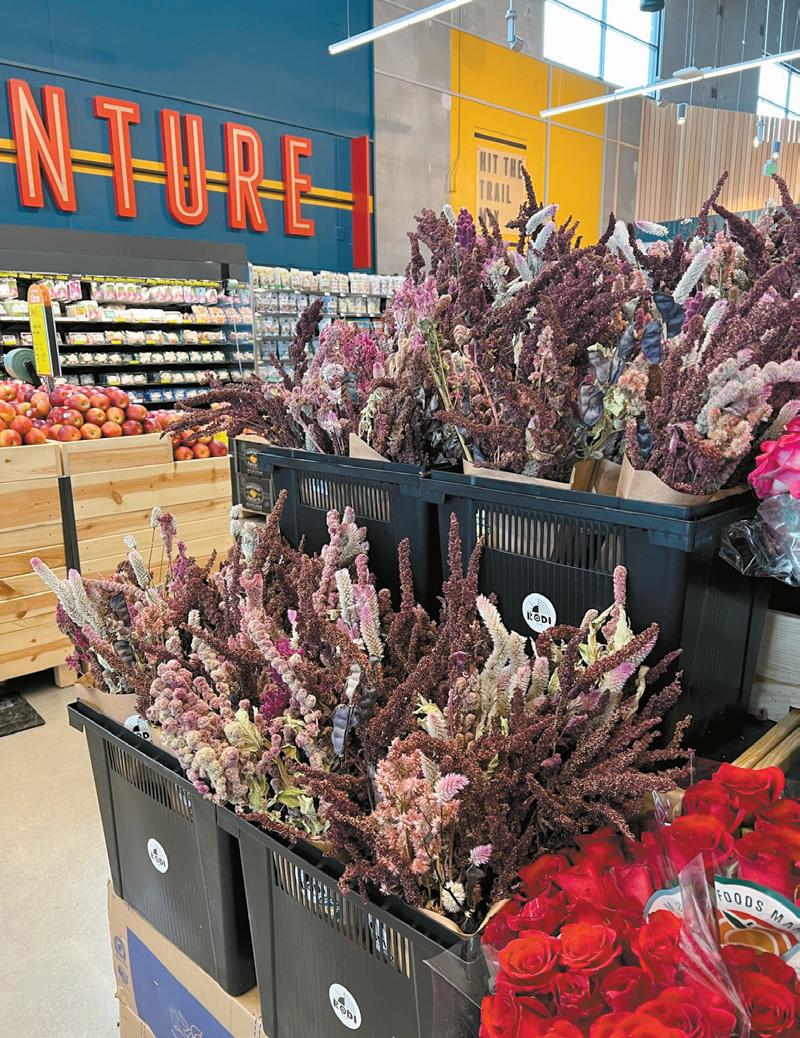
















By John McNamara
South Side Sparks 4-H Member
My name is John Winston McNamara, and I am an 11-year-old South Side Sparks 4-H club member. I was asked to write about what fires my passion to be involved in agriculture.
This is a really hard question, because there are so many things that inspire me about agriculture.
I was able to break it down into a few main things.
First, sharing agriculture with all people, farmers, and city folk gives me an opportunity to teach them to take better care of their surroundings, and of where their food comes from and what is put on their food.


When people understand where their food comes from and the ecosystems that grow the food, they will take better care of their planet and where they live. I love teaching people that you can do whatever you want to do, as long as it is good for the environment and community.
Second, agriculture is pretty much all things. Everything is related to agriculture. If Elon’s team of scientists had to go out and forage or grow their own food every day, Space X might still be a dream. Agriculture touches all things big and small, including us, and every day we have the opportunity to touch it back. It’s like a dance. It’s give and take, and it is very, very hard work.
I love agriculture because you can dive right in, like in 4-H.Agriculture isn’t just messy and dirty, and it doesn’t need to be un-fun, and it doesn’t have to be all serious.You can write on the extinction of the monarch butterfly, or saving the blue morpho butterfly (these were two of my 4-H projects).You can study how fast a certain plant grows, and even study some really cool genetics. One of my projects this year is growing dahlias. Did you know there are more than 57,000 known cultivars, and if you grow them from seed, each individual seed is genetically different because of what the pollinators do? On the farm we do everything we can to protect the pollinators because they live in a very fragile system these days.
Agriculture also solves a lot of problems.When agriculture is done with care for its community, it is therapeutic and doesn’t pollute. Agriculture solves the problem of laziness.You have to plant the crop, cultivate the crop, harvest the crop, feed the animals, take them to the butcher, and you have to be able to do this every single day.Agriculture has created a healthy life for me. It has created many new turns and learning curves for me, and the constant learning and constant working is really good for my brain.
Lastly, agriculture is not just livestock. It is truly much more. It can be raising exotic pheasants, raising exotic flowers, raising lavender, and, ultimately, just expressing who you are.
Thank you for the opportunity to write this and be able to be part of Montana Farmers Union. Montana Farmers Union helps agriculture.
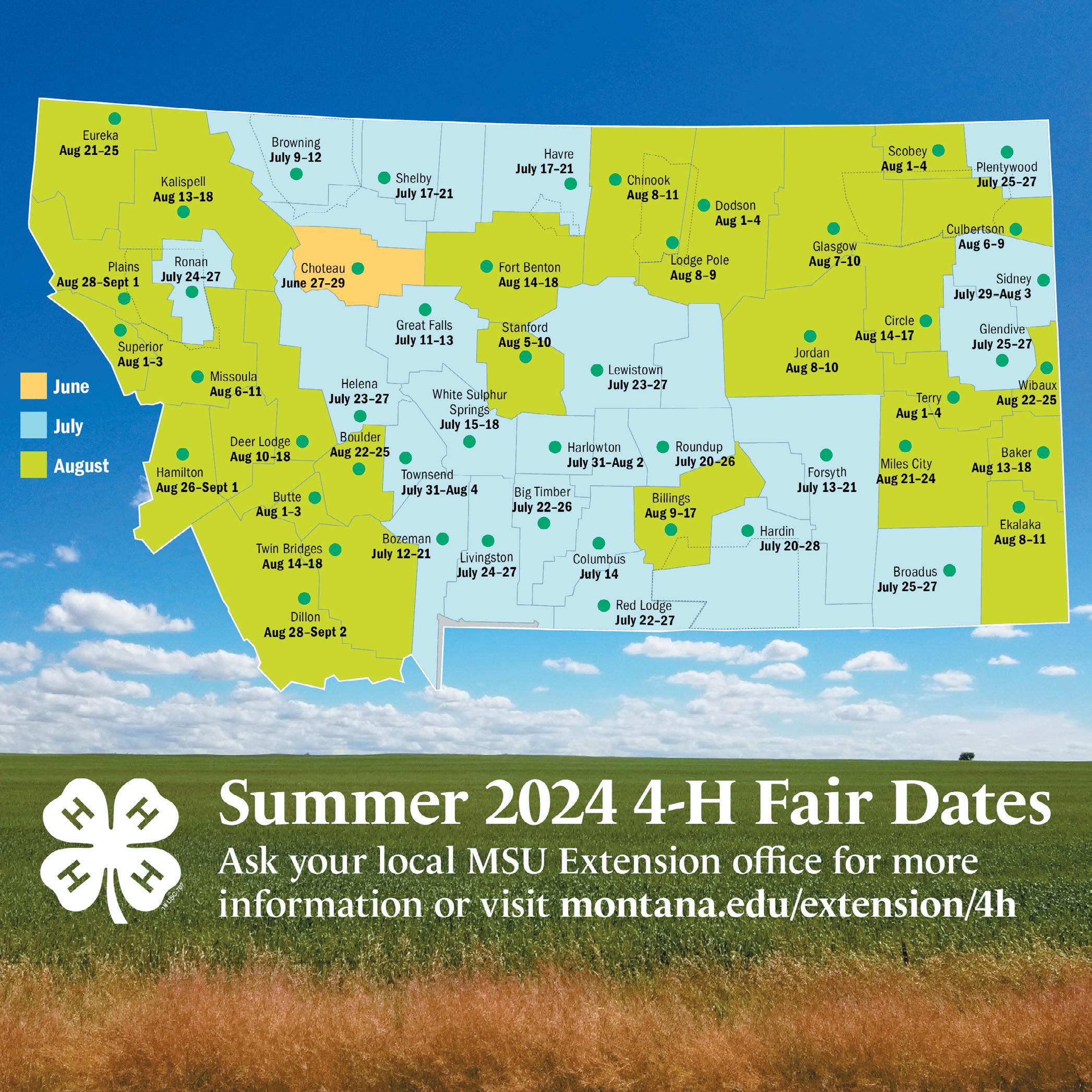
Montana State University Extension invites community members from across Montana to attend local and county fairs this summer to see Montana 4-H program displays and events. Montana 4-H is the youth development program of MSU Extension, and for 4-H youth, the fair is a public opportunity to show what they have learned and to continue developing civil service and social skills while running events like concession stands, petting zoos, or exhibits.
Community members are invited to fairs for 4-H exhibits and livestock sales and to learn more about the youth development program and how to participate through volunteering for events, leading a project, and more.
Montana 4-H is the largest out-of-school youth development program in the state, reaching nearly 20,000 youth in all 56 counties and seven reservations each year. Information about volunteering and supporting 4-H is available at montana.edu/extension/4h/volunteer/ index.html.
By Tracy McIntyre, Executive Director of Montana Cooperative Development Center








Montana boasts a rich history of cooperative enterprises, with more than 160 Montana-owned and operated cooperatives significantly contributing to the state’s economy. These cooperatives generate an impressive $7.1 billion economic impact, create more than 24,000 jobs, and contribute $1.6 billion to family incomes. The cooperative movement in Montana is not just an economic powerhouse; it is a



testament to the enduring value of community-driven business models.
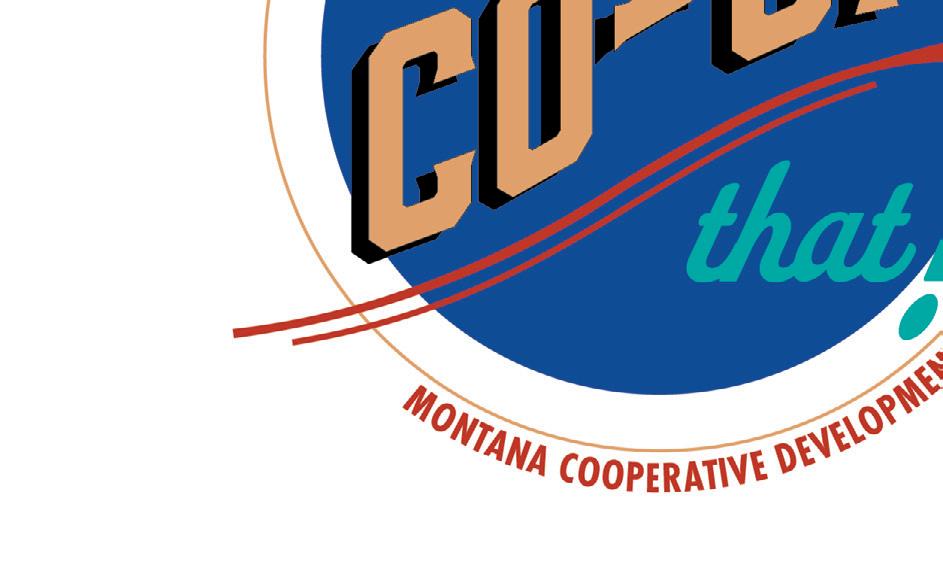

Cooperatives are among the oldest business forms in Montana, with some agricultural cooperatives dating back to the late 1890s. This long-standing tradition underscores the resilience and adaptability of cooperatives in meeting the evolving needs of Montanans. The agricultural sector has been a cornerstone, with more than 60 agricultural cooperatives playing a crucial role in supporting local farmers and ranchers.
Credit unions, telecommunications, and electrical cooperatives contribute significantly to the state’s cooperative landscape. Montana’s credit unions provide essential financial services to residents, while eight telecommunications cooperatives ensure connectivity in some of the state’s most remote areas. Additionally, 25 electrical cooperatives and their supply cooperatives work to deliver reliable power across Montana’s vast and rugged terrain. In addition, there are 30 non-legacy cooperatives. These include new and emerging cooperatives that address contemporary challenges with innovative solutions. This diversity ensures that cooperatives can meet a wide range of community needs, from economic development to essential services.


The Montana Council of Cooperatives is the unifying force for the state’s cooperative community. This 70-year-old organization is not industryspecific, allowing it to address a broad spectrum of cooperative needs and issues. The Council’s mission is to unite and strengthen cooperatives across Montana, ensuring they can continue to thrive and serve their members effectively. The Council operates through a series of districts and works closely with the other three cooperative associations of Broadband MT, Montana’s Credit Unions, and the Montana Electrical Cooperative’s Association.
One of the Council’s key activities is hosting an annual meeting, with the next one scheduled for Jan. 13-15, 2025. This event provides a crucial platform for cooperative leaders to share insights, discuss challenges, and explore opportunities for collaboration. A highlight of the upcoming meeting is the cooperative legislative dinner on Jan. 14, 2025, in Helena. This dinner will bring together cooperative leaders and state legislators to discuss policies and initiatives that can further support the cooperative sector.
The Montana Council of Cooperatives also


collaborates closely with the Montana Cooperative Development Center, the economic development arm of the cooperative community. Supported by both federal and state funding, MCDC’s mission is to foster the development of new and emerging cooperatives. This organization is vital for addressing community and economic needs through the cooperative business model. MCDC has developed a series of cooperative initiatives to address key issues facing Montana including housing, childcare, worker and community ownership conversions for businesses, investment and localize capital, and saving community gathering centers as seen in Whitewater with the North Development Cooperative.
MCDC’s work is essential in nurturing innovative cooperative models like the Musselshell Valley Development Cooperative and the Opportunity Development Cooperative of Petroleum County. These investment cooperatives exemplify how local people can create local solutions to meet their communities’ needs. By pooling resources and working together, these cooperatives can tackle challenges that individual efforts might not overcome. When MCDC says, “We Can Co-op That,” they do mean it.
Montana’s cooperatives are a vital part of the state’s economic and social fabric. They provide significant economic benefits, create jobs, and support family incomes while embodying the principles of community and cooperation. Organizations like the Montana Council of Cooperatives and the Montana Cooperative Development Center play crucial roles in uniting, supporting, and growing this vibrant cooperative community. As Montana continues to evolve, its cooperatives will undoubtedly remain key players in fostering sustainable economic development and enhancing the quality of life for all Montanans.

I’ve proudly served as an agent with Farmers Union Insurance since 2011. Operating out of offices in Great Falls and East Helena, I bring a wealth of experience and knowledge to my role, especially when it comes to protecting farm and ranch operations in our state. My roots run deep in Montana’s agricultural community, I grew up on a farm near Chinook, and my family continues to farm there today.This background provides me with firsthand insights into the unique insurance needs of farmers and ranchers in our region.
Currently, the insurance industry is navigating a challenging period known as a hard market, which has persisted for the past couple of years and shows no immediate signs of stabilizing.This hard market is characterized by rising premiums and stricter underwriting standards, largely driven by increasing claims from natural disasters like wildfires, wind, and hail, along with overall inflation.The situation is exacerbated by several major insurance carriers withdrawing from multiple Western U.S. states, further tightening the market and driving up costs.

Given these conditions, it’s more critical than ever for farmers and ranchers to work closely with their insurance agents. Regular policy reviews can uncover potential savings and ensure that coverage remains comprehensive and up to date. This proactive approach can help mitigate the financial strain caused by increasing premiums and ensure that all aspects of farm and ranch operations are adequately protected.
When it comes to insuring valuable items on the farm — such as equipment, hay, grain, and livestock — coverage options are available but evolving.Traditionally, insurance companies have offered blanket coverage for farm implements and equipment. However, there is a noticeable industry shift towards scheduled coverage, where each item must be individually listed on the policy. Despite this trend, Farmers Union Mutual Insurance Company still offers blanket coverage as an option. However, scheduling items individually may prove to be more cost-effective in the long run.This change underscores the importance of detailed and personalized policy reviews to determine the best coverage strategy for each operation.
Liability coverage is another critical aspect of farm insurance. Farm policies generally include liability protection to safeguard against various exposures unique to agricultural operations. Given the diverse and often unpredictable nature of farming, robust liability coverage is essential. In many cases, adding a Farm Umbrella policy can provide additional layers of protection.While basic liability insurance offers a foundational level of security, the complexities of each farm operation may require more tailored solutions. Consulting with an attorney can provide further guidance on mitigating liability risks beyond what insurance can cover.
By Eric Hinebauch - Hinebauch Agency Farmers Union Insurance

Looking ahead, while there are no specific opportunities for farmers and ranchers to directly influence changes in insurance offerings; staying informed and engaged is key. Regular policy reviews with your insurance agent are crucial to ensuring that coverage evolves in tandem with the operation’s needs.As new technologies emerge and farming practices diversify, insurance policies must be continuously updated to reflect these changes. Producers who take an active role in reviewing and adjusting their insurance coverage will be better positioned to protect their investments and livelihoods.
In conclusion, farmers and ranchers face significant challenges in the current insurance landscape. However, by diligently managing their policies and proactively engaging with a knowledgeable agent, they can navigate these challenges effectively. Adjusting coverage to address new risks and finding cost-effective solutions are essential steps. Collaborating with an experienced agent is crucial to safeguarding the future during these uncertain times.
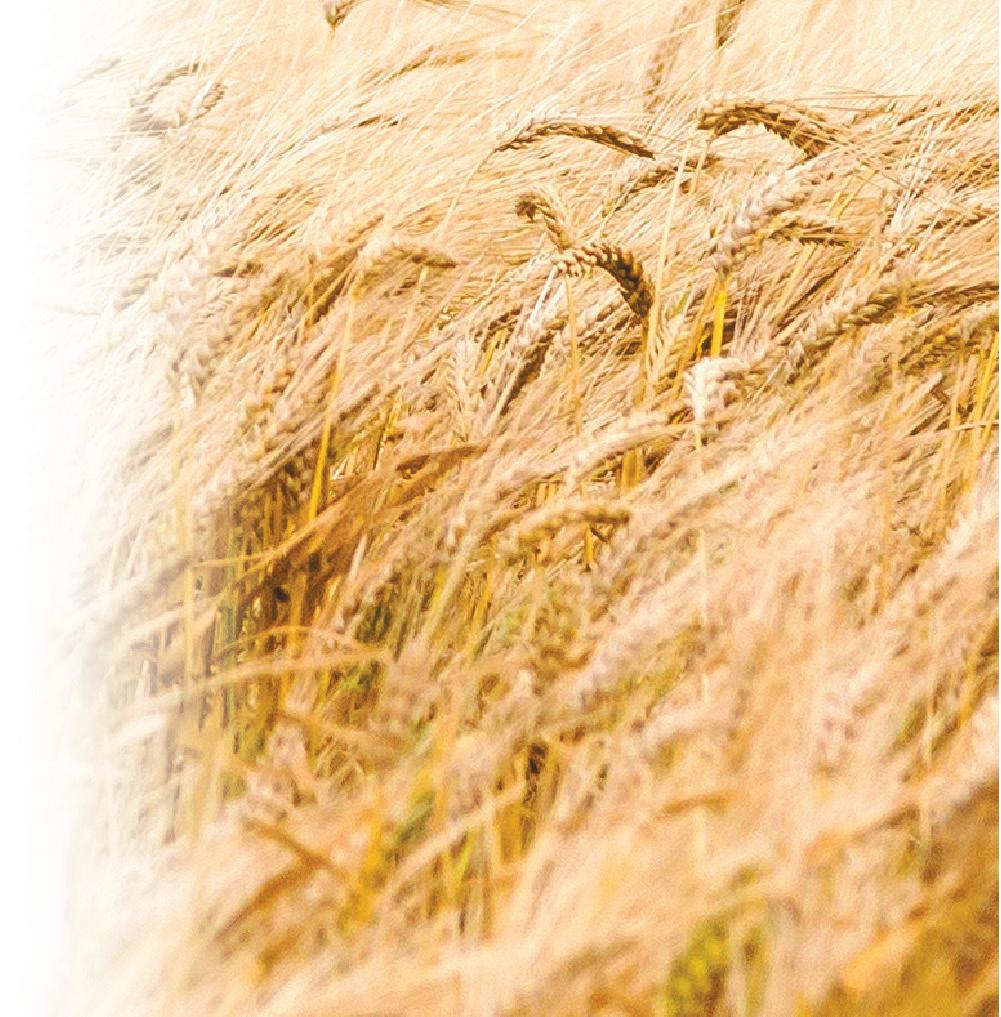


"Give us a callOur Agents Live and Work where you Live"
Anaconda
By Tracy McIntyre MCDC Director
Belgrade
Belt
Billings
Bozeman
Bridger
Broadus
Butte
Chester
Choteau
Circle
Stefanie Thompson: 563-5991
Craig Parker: 388-6774
Matt Triplett:952-0451
Judd Long: 252-9391
KJ Fauth: 969-2282
Art Hoffart: 586-6230
Dean Derby: 556-0893
Trent Leintz: 551-2163
By MFU STAFF
Wesley Schwend: 662-3930
Jesse Fleming: 436-2115
Mathew Luedtke: 270-5304
Megan Hedges: 759-5150
Scott Allaire: 466-5146
Kaylen Lehner: 485-3303
Coeur d" Alene
Conrad
Cut Bank
Dillon
Fairfield
Forsyth
Froid
Glasgow
Great Falls
Hamilton
Hardin
Havre
Helena
Production Director
Jeff Dow: 799-4096
Flathead Insurance 208-667-7485
Dirk Elings: 271-7047
Ashley Vanek: 873-2249
Judy Siring: 683-2365
Sara Nye: 683-1250
Matt Luedtke: 467-3444
Donna Manuel-590 0866
Watts Agency: 346-1196
Austin O’Dea :766-2205
Brady Burgess : 228 8282
Eric Hinebauch: 453-8413
Aeric Reilly: 570-5853
Kyle Tschetter: 836-7261
Bryan Jones: 363-6583
Melissa Wacker: 665-1867
Meagan Kinsella:265-2693
Alex Thornton:879-2028
Todd Crum: 443-4630

East Helena
Hingham
Hobson
Kalispell
Laurel
Lewistown
Libby
Livingston
Malta
Miles City
Missoula
Plains
Polson
Ronan
Ryegate
Seeley Lake
Scobey
Shelby
Sidney Sunburst
Terry
Thompson Falls
Whitefish
Wolf Point
Eric Hinebauch: 437-2053
Alissa McClendon: 397-3146
Ray Lipp: 397-3146
Shawn “Tater” Erickson: 366-1287
Flathead Insurance: 752-8000
Randy Bloom: 257-1252
Lorna Olson: 628-6649
Raleigh Heitzman: 538-8736
Bruce Marshall: 538-2331
Colleen Wood: 293-6228
Cole Mauch 222-7151
Shane Anderson: 654-1589
Tayler Kennedy: 874-2560
Watts Agency: 874-1804
Andre Marcure: 543-7184
Ben Barker: 721-2540
Josh Rollins: 830-3073
Pam Jacobsen: 721-0599
Tom Monaghan: 926-2552
Lisa French: 826-4633
Andrew Luedtke: 837-1395
Andrew Luedtke: 676-0173
Audrey Stoican: 568-2336
Tom Monaghan: 677-7400
Matt Stentoft: 487-2629
KW Insurance: 424-8480
Russ Seubert: 434-5211
Cathy Hintz: 488-8326
KW Insurance: 937-6950
Watts Agency: 635-5782
Lisa French 827-3221
Rial Gunlikson: 862-4700
Jesse Fleming: 653-2200
Director of PL Production Director of CL Production
Chris Strand: 871-2260
Ryan Kuntz: 581-4493

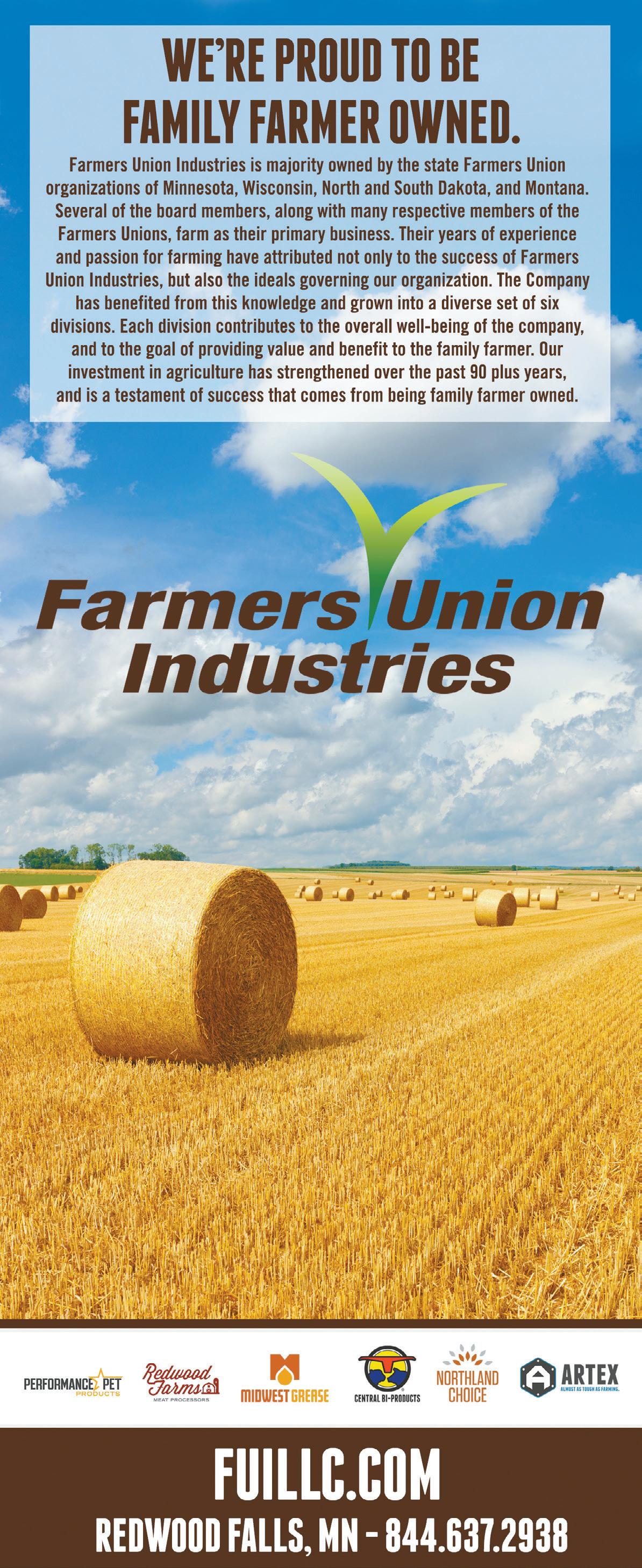

Most people associate summer in Montana with huckleberry picking, or at the very least enjoying huckleberry syrup or ice cream – a fitting connection considering huckleberries Montana’s official state fruit! The small berry is native to the Northwest and is found growing wild. The berries ripen in late summer. The darker the berry, the sweeter.
Check out the Montana Field Guide if you plan on foraging.
Here are some of MFU staff members’ favorite sweet and savory ways to enjoy them.


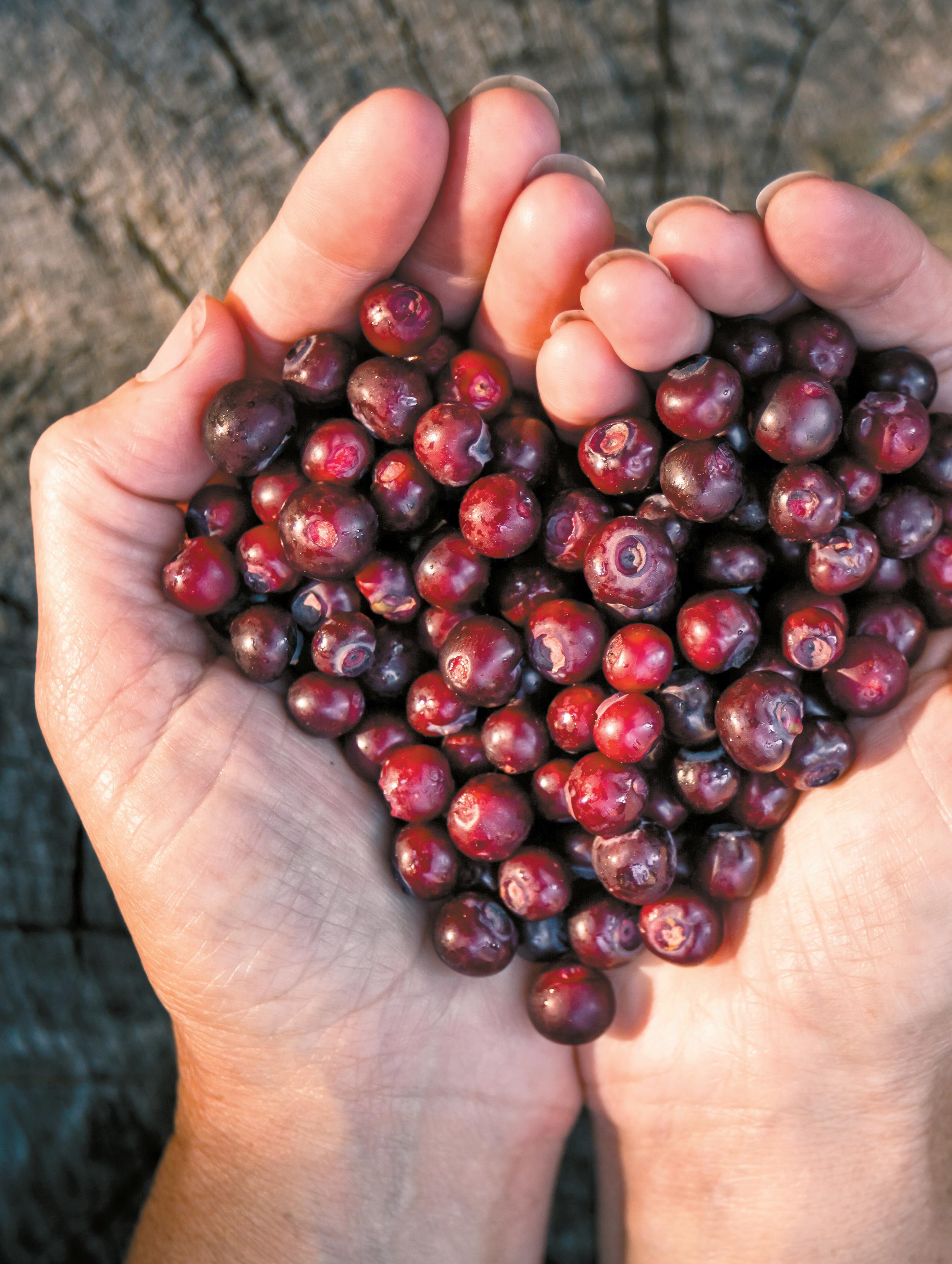















































































3/4 cup huckleberries, 1 Tbs reserved
1 tbs red wine
1 tbs red wine vinegar
1 tsp brown sugar
1 bay leaf
1 tsp butter, optional salt and pepper
Add all but 1 tablespoon of the huckleberries and the bay leaf to a saucepan. Let them cook a bit until they release their juices.
Add the red wine vinegar, the red wine, and the brown sugar. Add salt and pepper to taste. (You can also add a dash of nutmeg or red pepper for a zestier version.)
Simmer until the sauce reduces to desired consistency. Add the butter immediately before serving to thicken and add richness. Stir in the remaining huckleberries when adding butter. Spoon over protein of choice.

6 buns
Huckleberry Coleslaw
Pulled Pork (4-6 pound pork prepared)
Huckleberry BBQ Sauce
Huckleberry Coleslaw
1 (16 ounce) bag coleslaw mix
2/3 C mayonnaise
tap here
1/3 C fresh or frozen huckleberries
3 tbsp canola oil
1/2 C granulated sugar
2 tbsp cider vinegar
1/4 tsp salt
Huckleberry Barbecue Sauce
3 c tomato ketchup
1 1/2 C water
1/2 brown sugar
1/4 C sweet onion (I used Walla Walla), minced
1 tbsp red wine vinegar
1 C huckleberries (fresh or frozen) t
2 tbsp hoisin sauce
2 garlic cloves, minced
1 tbsp molasses
1/4 tsp ground cinnamon1 tsp ground dry mustard
Huckleberry Coleslaw
Place coleslaw mix into a large bowl.


Whisk together the mayonnaise, canola oil, sugar, vinegar, salt, and huckleberries in a medium bowl;
Blend thoroughly.
Pour dressing mixture over coleslaw mix and toss to coat. Chill at least 2 hours before serving.
Huckleberry BBQ Sauce
Combine all the ingredients (except the huckleberries) into a large sauce pan.
Bring to a boil.
Reduce to a simmer for 30 minutes on medium low heat.
Add the huckleberries and bring back to a boil.

Reduce back to a simmer and cook for another 15-30 minutes depending on how thick you want it. (The longer you cook it the thicker it will get).
Place bun on plate. Spread a good amount of coleslaw. Top with pulled pork. Top with BBQ sauce.




Cheesecake Filling
2 pounds cream cheese, at room temperature
1 1/3 C sugar
1/2 tsp salt
2 tsp vanilla extract
4 large eggs, at room temperature
1 1/3 C sour cream
Cheesecake Crust
1 3/4 C graham cracker crumbs
3 tbs sugar
1/2 stick melted butter
Huckleberry Topping
1 C (5 oz) huckleberries
2 tbs water
3 tbs sugar
pinch of salt
2 tsp cornstarch
2 tsp water
To make the crust:
Butter a 9-by-3-inch cake pan with removable bottom (or a springform pan), and wrap the bottom of the pan in a double layer of aluminum foil.
Stir the crumbs, sugar, cinnamon, and salt together in a medium bowl. Pour over the melted butter and stir until all of the dry ingredients are uniformly moist. Turn the ingredients into the pan and use the flat bottom of a glass (or cup) to pat an even layer of crumbs on the bottom of the pan and about halfway up the sides. Don’t worry if the crumbs are not perfectly even around the sides. Put the pan in the freezer while you preheat the oven.
Center a rack in the oven. Preheat the oven to 350 degrees fahrenheit and place the cake pan on a baking sheet. Bake for 10 minutes. Set the crust aside to cool on a rack while you make the cheesecake batter.
Reduce the oven temperature to 325 degrees.
To make the topping:
Put the huckleberries, water, lemon juice, sugar, salt, and cinnamon into a small saucepan. Bring the mixture to a simmer and cook until some of the berries begin to pop. In a small bowl mix together the cornstarch and water to make a slurry. Stir the slurry into the huckleberry mixture and cook until slightly thickened. Set aside to cool
To make the cheesecake:
Working with a stand mixer, fitted with a paddle attachment, or with a hand mixer in a large bowl, beat the cream cheese at medium speed until soft and creamy, about 4 minutes. Scrape the bottom and sides of the mixing bowl, to make sure that there are no unmixed lumps. Add the sugar and salt and continue to beat for another 4 minutes or so, until the cream cheese is light. Beat in the vanilla. Scrape the bowl again. Add the eggs one by one, beating for a full minute after each addition - you want a well-aerated batter. Reduce the mixer speed to low and mix in the sour cream and/or cream. Scrape the sides and bottom of the bowl one last time.
Bring a kettle of water to a boil. Put the foil-wrapped cake pan in a roasting pan that is large enough to hold the pan with some space around it.
Scrape the batter into the pan. The batter will come all the way up to the rim of the pan. Put the roasting pan in the oven and pour enough boiling water into it to come halfway up the sides of the cake pan.
Bake the cheesecake for 1 hour and 30 minutes, at which point the top should be browned and may have risen just a little above the rim of the pan. Turn off the oven and prop the oven door open with a wooden spoon. Allow the cheesecake to cool in its water bath for another hour.
After 1 hour, carefully pull the setup out of the oven, lift the pan out of the roaster - be careful, there may be some hot water in the aluminum foil and remove the foil. Let the cheesecake come to room temperature on a cooling rack.
When the cake is cool, cover the top lightly with plastic wrap and refrigerate for at least 8 hours; overnight is best.
At serving time, gently run a knife around the top edge of the pan-you don’t have to reach all the way to the bottom. If using a cake pan with removable bottom, set the pan on a large, sturdy can. Hold the top edge of the pan on opposite sides and push down steadily. If using a springform pan, use the same method, remembering to release the clip.
Spoon the huckleberry mixture on top of the cake, spreading it gently to the edges.
Filling
1 C fresh or frozen berries
pinch salt
1/2 C sugar
2 1/2 tsp cornstarch if using fresh berries, OR...
1 tbsp cornstarch if using frozen berries
2 tsp fresh lemon juice
Empanada Dough
1/2 C shortening
3 C all-purpose flour
2 tsp baking powder
1/2 tsp salt
2 tbsp granulated sugar
2 eggs
1/2 C evaporated milk
Glaze
Canned evaporated milk
Raw sugar
Empanada Dough
In a stand mixer cream the shortening and then combine the dry ingredients. In a separate bowl whisk the eggs and milk and add to dough mixture until you have a soft dough. Remove dough from mixer and add flour to dough if sticky. Split the dough in half, wrap in plastic wrap, and refrigerate for about 20 to 30 minutes.
Assemble and Bake Empanadas
Preheat the oven to 350 degrees F.
On lightly floured surface, roll chilled dough 1/8 inch thick. Cut out 4-inch circles.
Place a small dollop of preserves on one half of each of the dough circles.Wet the bottom edge of the circles with water to help seal the two halves. Fold over the dough to cover filling and seal off the edges with a fork by pressing down along the edges.This also makes for a pretty pattern when baked.
Repeat with remaining dough and filling. Brush each empanada with evaporated milk and sprinkle with raw sugar. Puncture two slits on the top of each empanada with a fork to allow steam to escape while baking.
Spray a large cookie sheet with cooking spray; place the empanadas on the cookie sheet and bake for 15 to 20 minutes on middle rack in the oven. If after 15 minutes you notice the bottoms of the empanadas starting to brown, move the cookie sheet and set the oven to broil and bake for 1 to 2 minutes, until golden brown.

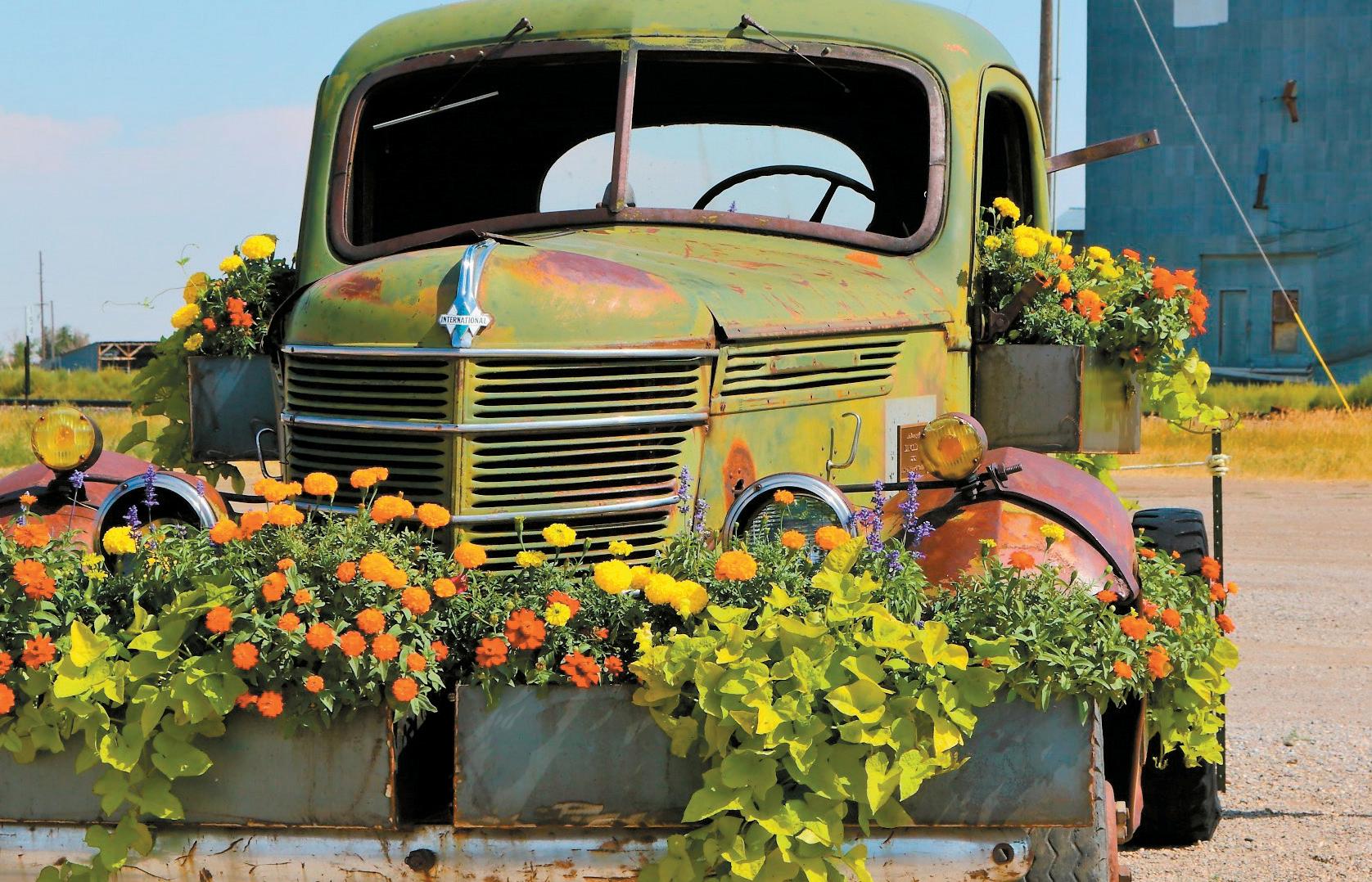
If you happen to be driving by Stanford this summer or fall, do yourself a favor – slow down, pull off Highway 87, and cruise the four blocks of Main Street.An army of volunteers with the Stanford Beautification Project plants cattle trailers full of flowers for the enjoyment of community members and any lucky traveler wise enough to take a short detour through this lovely rural town.
Tess Brady is widely credited as the one that makes it all happen, but she doesn’t have much to say about that topic. She does get animated when asked about the other volunteers and rattles off names and skills.A poster for a recent fundraiser, Extravaganza, listed two phone numbers to call for information. One number was for Alberta Anderson, who year after year doggedly promotes fundraising efforts.This year, the money raised will allow the Beautification Group to buy a 4-by-4 to water the flowers.
The other number belonged to Janine Merrill who Brady called the marketing gal. Merrill explained that she gathers sponsorships and manages advertising for events.When asked why she does it, Merrill said,“I work at the bank on Main Street and have made my living here; it is a way to give back.”
Like Brady, Merrill was quick to give names and numbers of other members like Jo Roland and Amy Dell, who she said do so much more and really deserve a lot of credit.
Eilene Porter, a Montana Farmers Union member, drives the horse trailer to get the flowers for planting. Brady explained,“She can back the trailer up; I’d wreck it.”
When it comes to Brady’s unique skill, Porter was quick to give her credit for being humble. Even so,“she can certainly get volunteers, and she doesn’t have to threaten them either.”
Along with the unique skillsets each volunteer brings to the Stanford Beautification efforts, humility, charity, selflessness, hard work, planning, and hometown pride are characteristics every volunteer demonstrates.The combination is key to the group’s efforts to beautify Stanford. If the resulting flowers are any indicator, it’s certainly a winning combination.
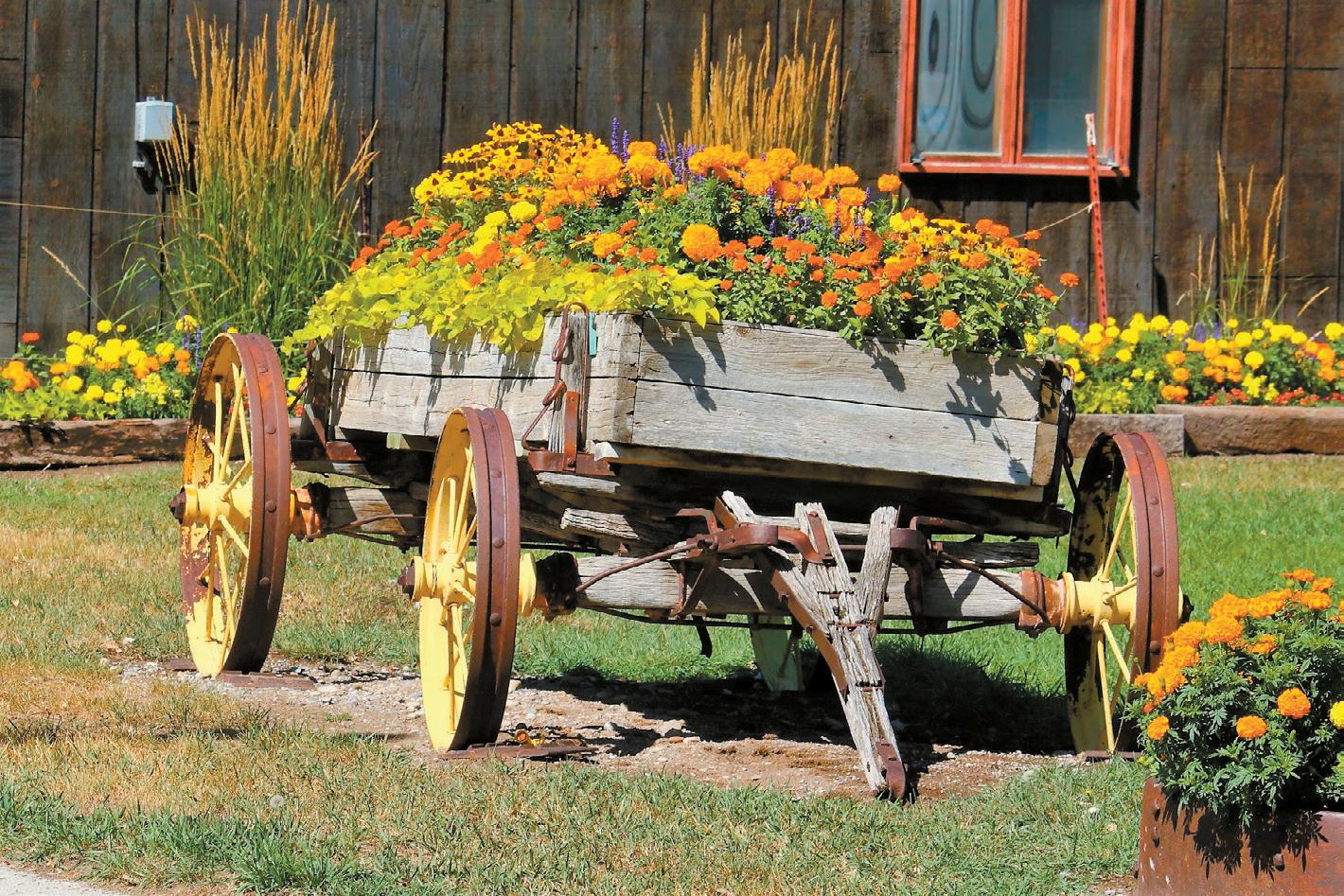
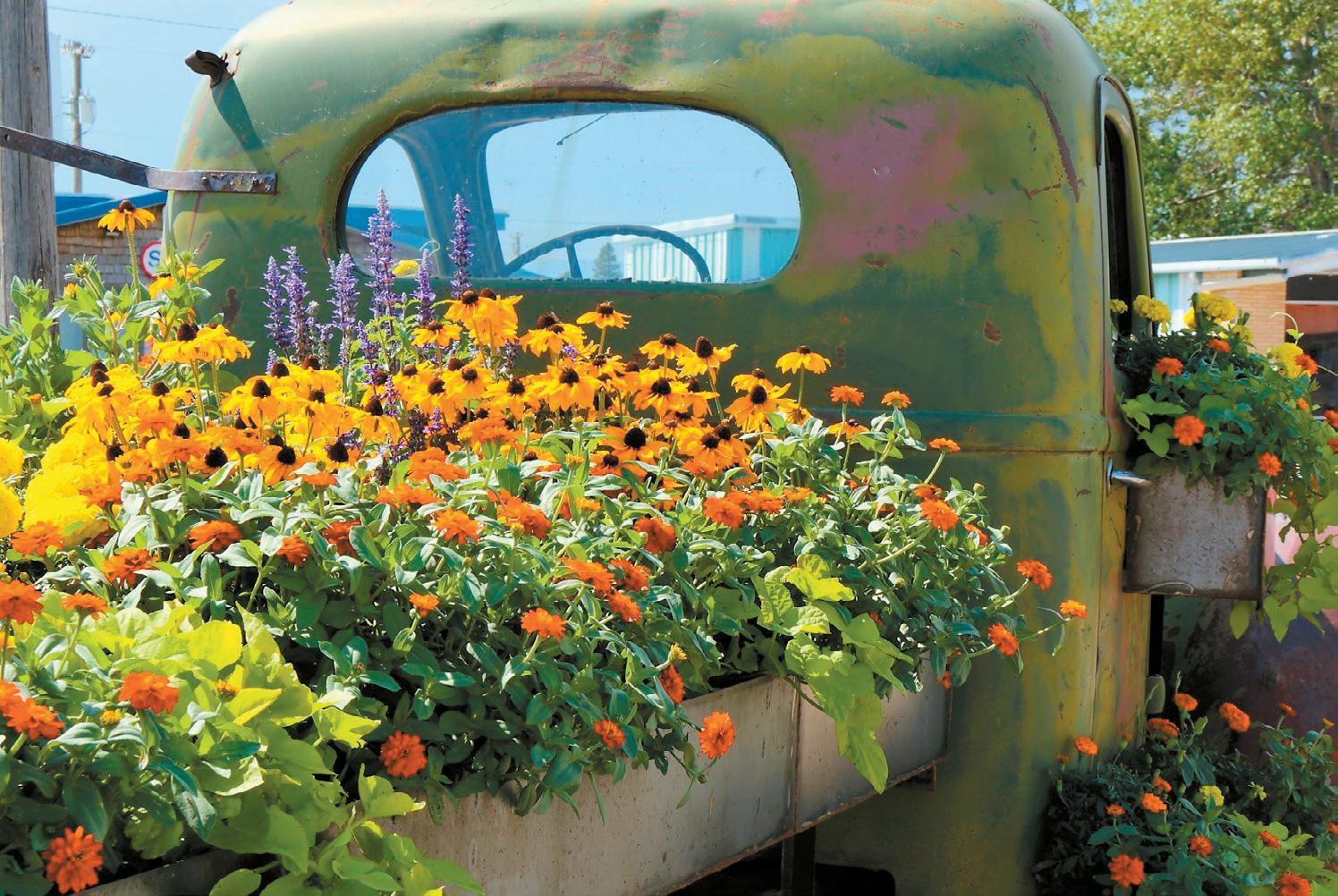
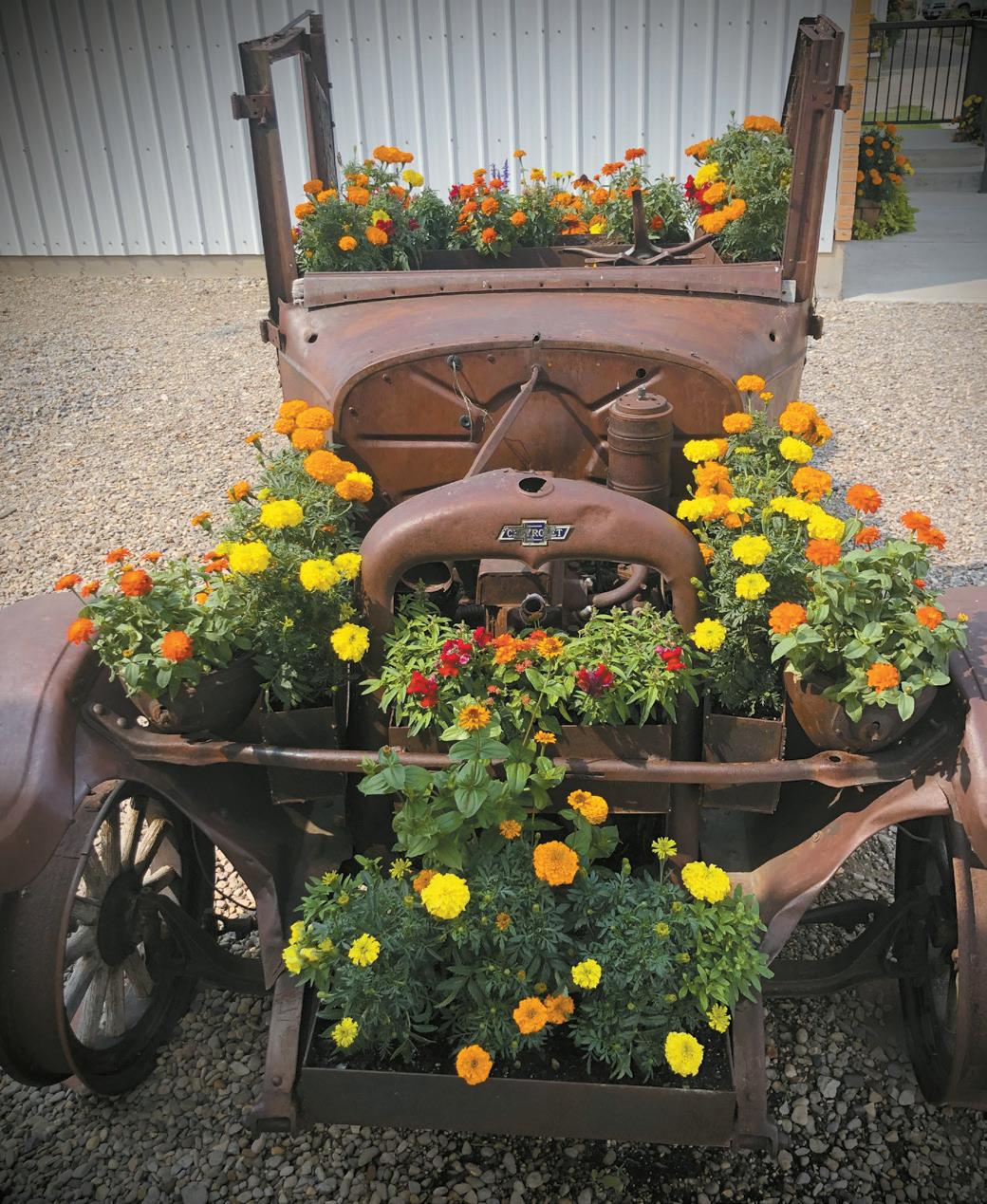
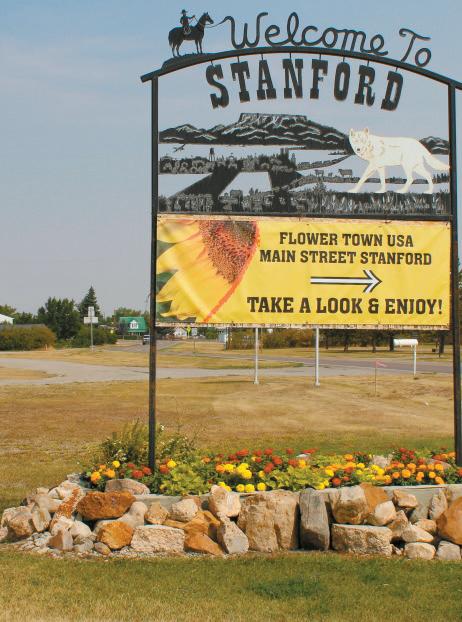
Brett DeBruycker works the same land outside Dutton where he grew up with five sisters and a brother.Third-generation Montanans, Brett and his siblings held tight to their agricultural heritage.Their children grew up in farming and ranching, too; some already have joined the family business.
“We’ve chosen to market our cattle as a family, under the name DeBruycker Charolais,” Brett said.“We choose to help each other out as best we can.As a family, you want to work together.”
Brother Mark’s operation is outside Bynum. Sister Cathy and husband Joe Campbell farm and ranch outside Choteau.
The depth of the DeBruyckers’ connection to agriculture is a rarity these days. Even in Montana’s longtime ag towns, many folks no longer have a direct connection to farming or ranching.“So few people understand agriculture anymore,” Brett said.
That means, when summer or high school graduation come around, young people look for work at retail or service businesses in town – or miles away in one of Montana’s larger cities.
As have many of Montana’s 27,000 farms and ranches, the DeBruycker operations have looked for new ways to fill out their seasonal workforce over the last decade. It’s been a tough transition, but they’re making it work – one job at a time, utilizing several federal, regional and state programs that match ag operators with workers.
“Every industry is struggling to find the employees they need,” said Logan Kruse, communications director at the Montana Department of Agriculture.“But also, agriculture is an industry where you don’t clock in and clock out.You’ve got to do what you’ve got to do. It’s hard work.”
“Agricultural production was such a commonality in the past,” Kruse said.“Back in the day, Montana kids went to college fully expecting to return to the farm.That’s changed, all while the average age of our producers has increased. Operations look very different these days.”
Even so, about 31,000 Montanans work in production agriculture, according to Montana State University statistics.
Brett DeBruycker grows winter wheat, chickpeas, lentils and barley, raises and markets Charolais cattle, puts up hay and sells bulls. His four daughters grew up on the ranch outside Dutton, learning alongside their mom and dad.
But the family needs another five to seven seasonal workers to keep the operation going. Over the past decade, Brett found and cultivated that workforce through the U.S. Department of Labor’s H-2A program.
The H-2A temporary agricultural program allows producers who anticipate a shortage of farmhands to bring non-immigrant foreign workers to the U.S. for a maximum of 10 months per year. Employment is tied to the production cycle; the guidelines are strictly enforced.
Brett DeBruycker learned about the program from a young South African man who worked for a custom cutter he contracted with during the harvest about a decade ago.“I could see that the local workforce interested in doing ag work was shrinking,” Brett said,“and I’d been seeing these custom cutters utilizing the H-2A program.Then one of the South African kids working for a custom cutter asked if he could come work for me. That spurred me to go in and figure out the program.”
By Sherry Devlin


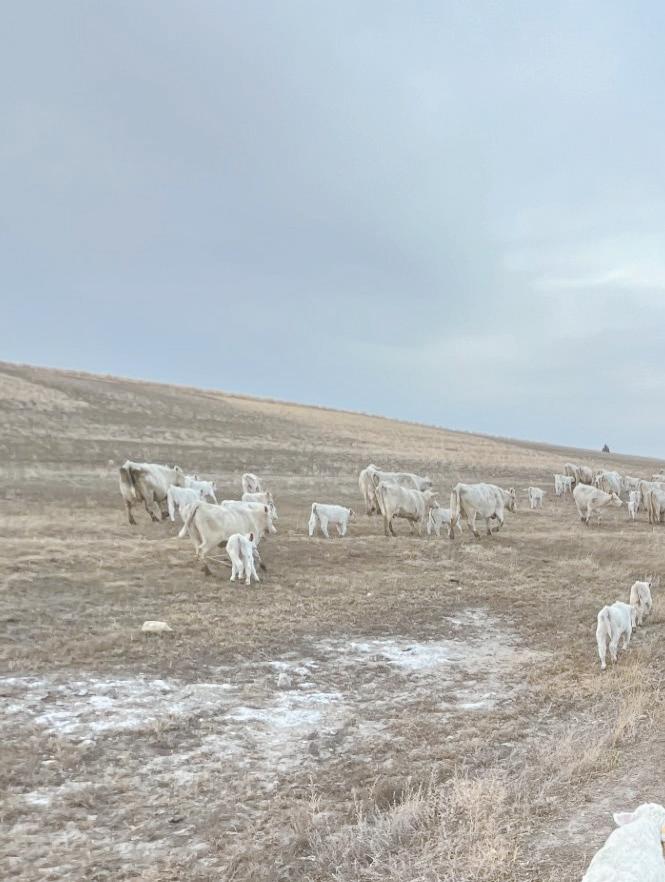
The transition, he said, has been what you’d expect.“You can run into great people or run into people who you don’t enjoy that much. Over the years, I’ve gotten hooked up with a group of young people from South Africa who are really enjoyable to be around and who want to work.”
DeBruycker hires a firm in Tennessee to do the necessary H-2A paperwork. In between seasons, he keeps in touch with the South Africans via email. If any decide not to hire on for the next season, they recommend a friend to take their place.
Their motivation: money.“The dollar exchange between the U.S. and South Africa is pretty drastic, so these kids go back home with a lot of money in their pockets,” DeBruycker said. “They can help their families, and possibly set up their own business or their own ag operation after a few years here.”
The H-2A workers don’t arrive with farm or ranch experience, so there’s a learning curve.“I’ve had to teach pretty much everybody,” he said.“But that’s the same with just about anyone new.That’s a risk.”
Nationwide, the federal Labor Department certified 378,000 seasonal farm jobs filled by H-2A workers in FY2023, up 2 percent from the prior year.Those workers went to 13,000 farms and ranches; half of the H-2A workers are in California, Florida, Georgia,Washington, and North Carolina.
Montana farms and ranches hired 1,695 foreign workers through the H-2A program in FY2023, a 16% increase from the prior year.The laborers earned an average $16.54 an hour last summer.Ag producers typically pay $100 to $250 per worker to a recruiter, if they need to find new crew members, but most H-2A workers return year after year. If the producer doesn’t

have an in-house person to process H-2A applications, he’ll pay $1,500 to $3,500 per contract to an agent or attorney.
In June, the USDA announced $50 million in Farm Labor Stabilization and Protection Pilot Program Grants to 141 recipients, including $100,000 to Vilicus Farms to help with creating an employee handbook and implementing incentives such as bonus pay and sick leave programs.
Goals of the voluntary USDA program include increasing access to agricultural labor through the H-2A visa program, strengthening protections and pay for farm workers, and building pathways for legal immigration. National Farmers Union engaged throughout the pilot process to ensure the FLSP would support family farmers and farm workers, enhance the resiliency of the U.S. food supply chain, and support lawful migration pathways.
The program will make it easier for responsible ag employers to find and hire qualified employees, said NFU President Rob Larew.“The result is a mutually beneficial solution that will create a more functional and compassionate farm labor system.”
Anna Jones-Crabtree, who runs Vilicus Farms and Vilicus Institute with her husband Doug Crabtree, said she hopes the new programs and clear expectations the grant will help them implement and layout will help bridge the mismatch between what employees want for work-life balance versus the demanding hours and limited security of farming.“It has to be more than just getting paid dollars per bushel.”
Continued on next page

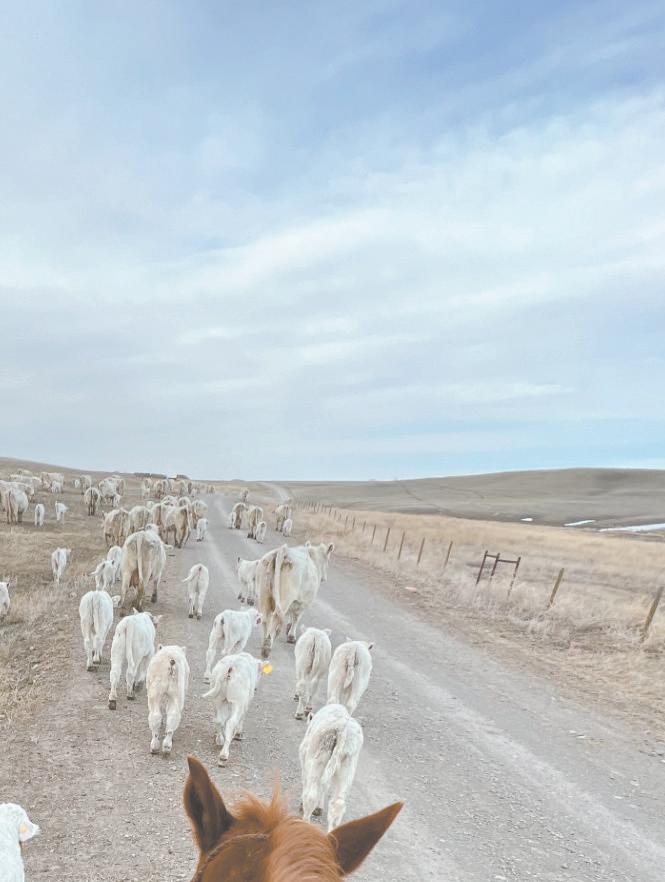
Since founding their organic farm north of Havre in 2009,Anna and Doug have sought to address how to attract and retain employees in a rural area with limited housing and services. Initially, they worked with interns but had trouble recruiting U.S. workers when other jobs in the agricultural sector offer steady pay and hours.
The past several years,Vilicus has used the H-2A program.This year’s crew of three women and two men from South Africa are eager to work, but the same workers don’t always return, and Anna said they must train new employees to help with their complex operation that includes upward of 15 crops laid out in smaller strips, conservation programs like pollinator habitat, and integrated grazing.
“It’s a significant time sink in terms of the energy drain every year. Just the onboarding is huge,” Anna said.
Time spent training is time that could be spent investing in value-added opportunities or being more responsive to ideal windows of time for seeding and harvest.“It’s not just our time; it’s impactful to the farm,” she said.
The employee handbook the USDA grant is helping them finalize also will be used to pursue a Regenerative Organic Certification. “The certification’s not just how you grow a product, it’s also how you’re treating your people, and that allows us to have a different conversation about marketing and pricing,” Anna said.

Ultimately, the USDA grant will help them be proactive in providing employment opportunities that are fair and supportive for workers,Anna said.“In Ag, we need to figure out how we can step up. For Doug and me, it’s about the team.”
New Agrarian Program Apprentices
Once upon a time, most young people received the education needed for their chosen profession by way of an apprenticeship –be it doctor, lawyer or craftsman.The apprentice agreed to work for an experienced practitioner for a certain length of time; in return, they gained a trade.
That age-old approach continues at Montana farms and ranches
through Quivira Coalition’s New Agrarian Program.
“It’s hard for producers, especially in more remote areas, to find help that sticks around and is actually helpful to them,” said Luka Samson, one of Quivira’s two coordinators in Montana.“Our apprentices feel called to ranching and regenerative agriculture. They’re looking for a place where they can learn.”
This summer, 12 Quivira apprentices are working in Montana, at 11 different operations. Most have college degrees, although relatively few of those degrees are in agriculture. Many tried a different line of work first thing out of school, but eventually realized they wanted to work in agriculture. Samson filled every request from a producer this year.
Each November, Quivira opens applications from producers who want to mentor a New Agrarian apprentice the next growing season.Apprentice-hopefuls also apply for the program.
“Our program is not about the experience people come with, but about matching the personalities of each mentor and apprentice,” Samson said.“The ranchers who are successful with apprentices year after year are the ones who enjoy the mentoring aspect.The fact that they’re getting affordable help on the ranch is a factor, of course, but they really need a commitment to fostering the next generation.”
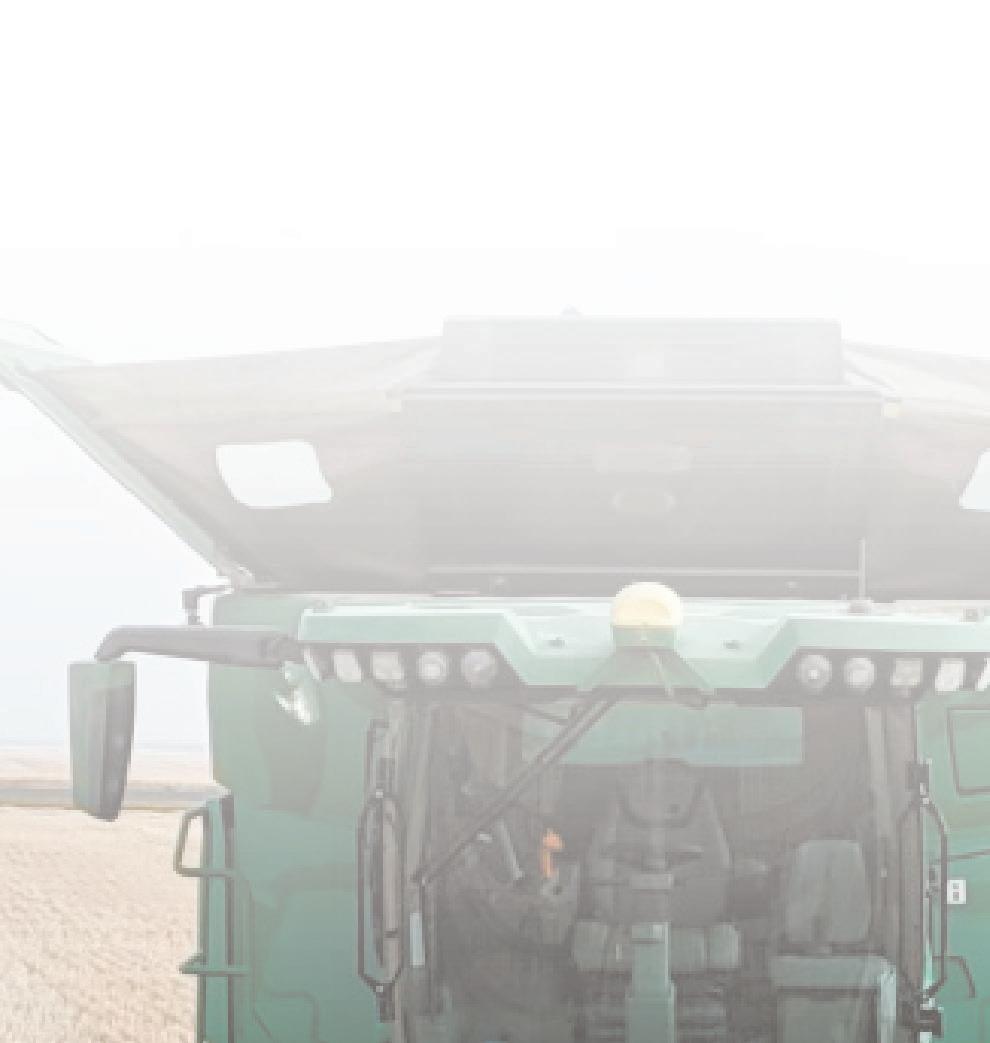
Apprentices have access to all the mentor applications, and respond directly to the producers. Farmers and ranchers make the hiring decisions, with help from Quivira’s coordinators, who are part of the interview process. Quivira provides an orientation program, plus on-the-ground training, and regular contact throughout the season.
Quivira has a short, but critical, list of requirements for each mentor-producer:The Quivira Coalition was created in the 1990s with a mission to build healthy working lands, healthy communities, and a bridge between ranchers and conservationists. So all producers involved with the New Agrarian apprenticeship program must show a commitment to healthy soils and landscapes.
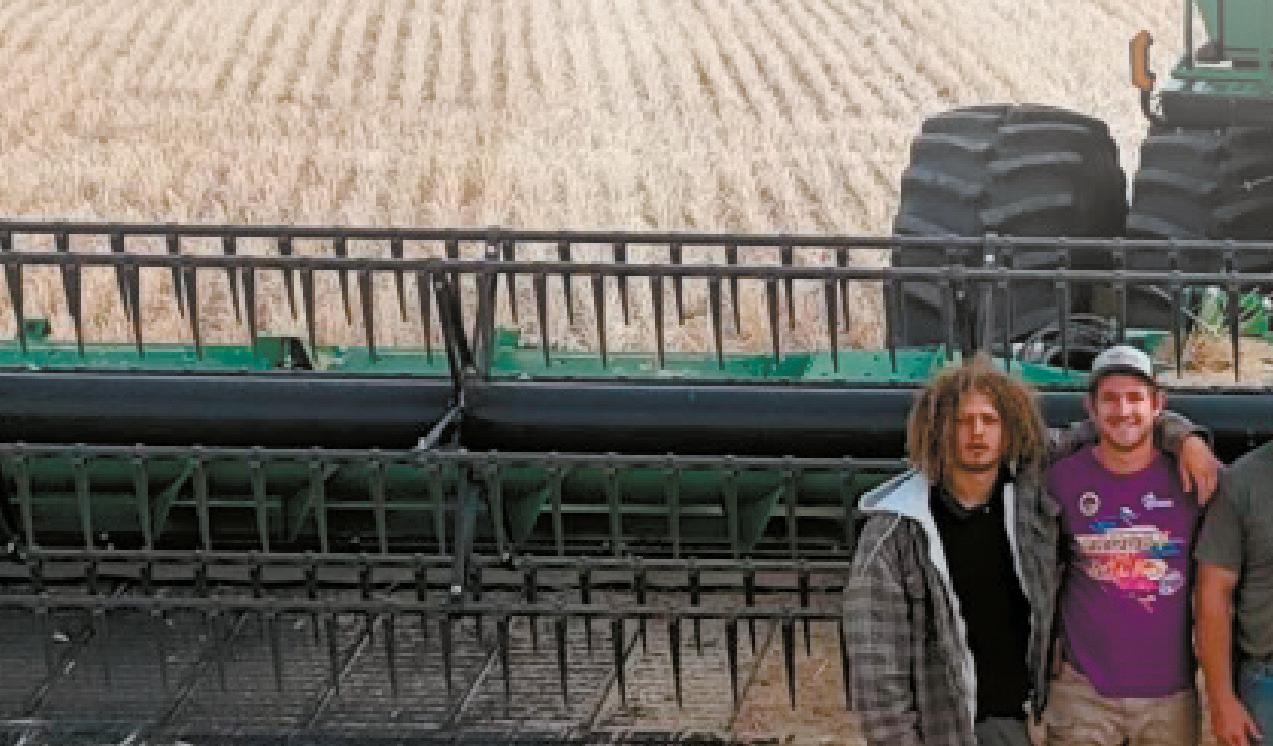
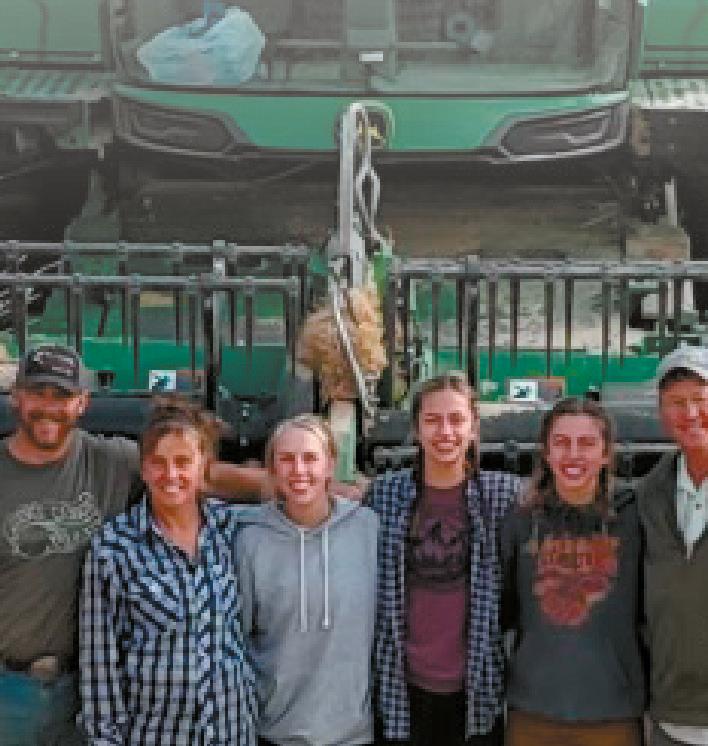

The rancher/farmer must pay their apprentice $1,500 to $2,500 a month – in addition to providing housing and either a food stipend or daily ranch meals or ranch commodities.They’re also required to “actively mentor” the apprentice, providing an average 8 to 10 hours a week of 1-on-1 instruction.
The approach works to build the next generation of agricultural leaders, Samson said.“We have a reputation that our apprentices are desirable workers.They’re really curious and eager to learn. Our mentor-ranchers really enjoy these young people.”
Along the way, Samson has seen what does and doesn’t work to motivate – and retain – seasonal workers.
“It’s important to see the human side of your workers,” she said. “Show them you really care. Show an interest and curiosity in people and who they are, what they’re trying to achieve. How can I, as an employer, help them achieve their goals? Producers can’t pay super-high wages, but they can fill an employee’s cup in other ways.”
One of Quivira’s mentors ends each day with a conversation about what went well and what didn’t go well – and asks his apprentice what their day was like. Several mentors put their apprentice in charge of a specific, sometimes new, project. One apprentice had an interest in goats; her mentor bought 100 goats and let her take the lead on their care.Another mentor recently attended a roping clinic with his apprentice, showing vulnerability and commitment to learning.

New Agrarian apprentices spend one season – March through November – on a farm or ranch, but can extend that to a second season.At several points each season, they write about the experience for Quivira’s website.Their words are frank, but give producers a clear idea of what life is like for seasonal ag workers.
“What is perhaps most humbling is the grit required to live in this landscape and grow food in it,” said Charles Abbott, who interned at the Indreland Ranch.“The winters are long and harsh, the summers are hot and dry, the wind is demoralizing, and other than a good dog, companionship is often scarce.”
But for every tough experience, there’s a note harkening to the centuries humans have spent tending the land and finding peace and happiness in the work.
Listen to Emma Davis, who apprenticed at Vilicus Farms before they began using the H-2A program:
“What I have come to appreciate most … are the small things. An evening walking through a coulee and having the vast landscape reduced to a single type of grass beneath my boots.The unique excitement that comes from seeding all the legume strips before a big rain and appreciating the true value of moisture. Beginning to learn the basics of operation and maintenance of the machines on the farm.Time to think on the drive home from our northernmost fields.”
Quivira has more than 100 alumni of its New Agrarian Program, and about 80% have stayed in agriculture or ag-related fields, Samson reported. Some now work as ranch managers. Some started their own ag operation; some joined their family’s operation with new enterprises. Others work at federal agencies or nonprofits providing direct services to farmers and ranchers.
Tracy Schmidt helps farm workers improve their lives. Sometimes, that means providing the education or certification needed to earn a raise. Other times, the education leads laborers down a new path, away from the farm.

But she believes that Rural Employment Opportunities and the federal training grants it provides ag workers and their families are part of the solution to worker shortages facing many farms and ranches. Schmidt is an employment and training specialist at REO, which has offices in five Montana cities.
REO manages Montana’s portion of a sizable, ongoing U.S. Department of Labor grant allotted nationwide. Its target: migrant and resident seasonal farm workers who want further training. Applicants must have worked in agriculture during the past two years, and most of their income in the past 12 months must have come from an ag operation.
Continued on next page



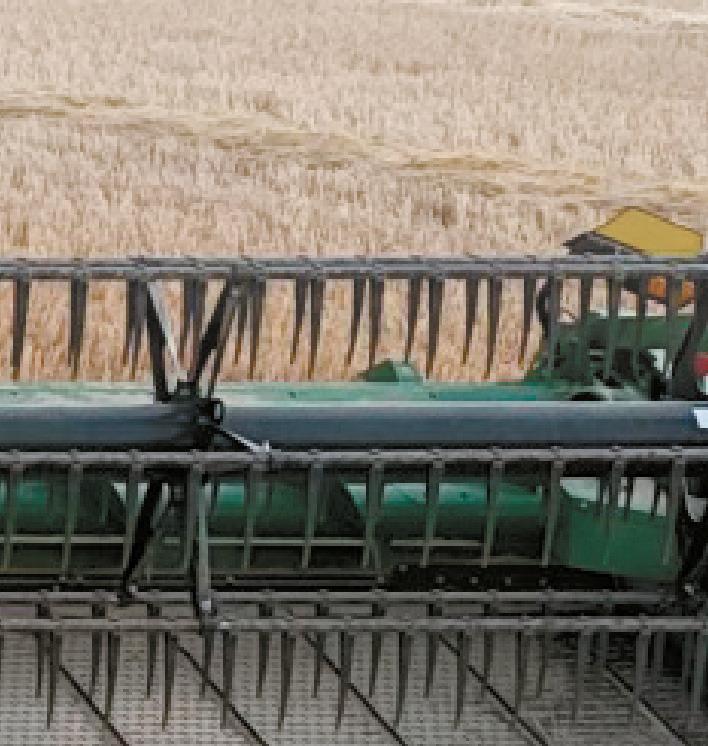

Continued from previous page
Beyond those sideboards and a set of income limits, the program is wide open.An individual’s desired training or higher education can be in agriculture-related fields or skills – or not. Some of REO’s clients have left farming for nursing or commercial trucking. Many, however, improved their skills with an eye toward staying in agriculture.
“We try to help people who are already working in agriculture increase their income stability,” Schmidt said.“It they choose to stay in agriculture, that’s great.”
“What I’ve learned about the people who want to stay in ag,” Schmidt said,“is that they want their income to be higher.That’s the motivation.”
Farm wage statistics provided by the federal government via https://www.onetonline.org/ show average annual wages for Montana farm workers of $34,440, compared to a national average of $35,120.That’s an average hourly wage of $16.56, with some Montana farm hands earning as much as $46,830 a year.
“A lot of folks will do a two-year or short-term training program to increase their value,” Schmidt said.“They’ll get their welding certificate and take that back to the ranch, or go to the Ag Mechanic program at MSU-Northern, or the diesel mechanic program. Now they have an ace in the hole and can ask for higher wages, or they can contract out to other folks and earn extra income on the side.”
Educational funding also is available for the families of farm workers – spouses who want to supplement the family’s income by becoming a Certified Nursing Assistant or medical transcriptionist, for example.
“We don’t just help the ag worker,” Schmidt said.“We help their spouse and their children – and that helps the producer keep a good employee because everyone in the family is happy and content.”
Some Montana State University students have worked with REO to secure grants that help pay for their degrees in agriculture, securing the necessary time on the job by working during summer break, calving season and the harvest.
“We have quite a few participants in range management and animal science at MSU who work on ranches in the
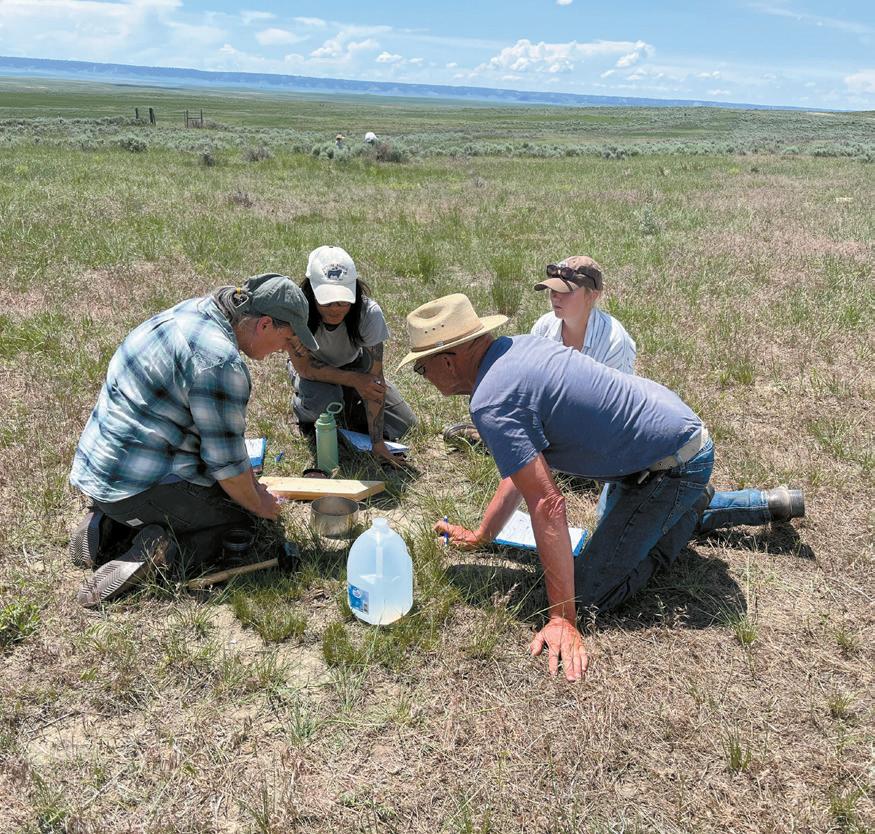
summertime and go back repeatedly,” Schmidt said.“It’s great for their hands-on learning.They’re just trying to get through college so they can get on the ranch full time.”
The evidence is early and anecdotal, but Americans seem to be reconnecting with agriculture, said Logan Kruse, at the Montana Department of Agriculture.And that possibility carries all sorts of positives: a better understanding of where food comes from, more direct sales from farmer to consumer, more interest in agriculture as a career.
“It’s the one positive that came out of Covid,” he said. “Consumers started thinking about where their food comes from after meat didn’t show up on the shelf. People are starting to think about the food system, and that’s encouraging a societal shift to support agriculture and the family farmer. It helps younger people see the value in returning to the farm, in moving back home.”
At DeBruycker Charolais, the family’s fifth generation is now part of the workforce, a tale Montana ag officials are hearing with increased frequency.
“It’s just a gut feeling,” Kruse said,“but this seems like the first stirrings of change.”

For more information on the H-2A program in Montana: Contact Big Sky Labor Solutions, email bigskylaborsolutions@gmail.com, or call 406470-1178 or 406-399-3219.
Contact: Quivira Coalition, New Agrarian Program, Luka Samson, Northern Plains coordinator, Luka@quiviracoalition.org, or call 406-219-1470.
Rural Employment Opportunities has offices in Havre, Billings, Plains, Lewistown and Helena. Learn more online at reomontana.org or email Tracy Schmidt at tracy@reomontana.org, telephone 406-274-4172.
USDA Farm Labor Stabilization and Protection Pilot Grant Program: https://www.ams.usda.gov/ services/grants/flsp

Montana Farmers Union will again celebrate family farmers and ranchers whose land holdings have been in their families and in operation for more than 100 years through its Centennial Farm and Ranch Program during MFU’s Annual Convention this year.
Since the mid-90s, Montana Farmers Union has been honored to recognize agriculture producers who have owned the same farm or ranch for 100 years or more. Nearly 200 farms and ranches have since been recognized. When an MFU member reaches this milestone, they are honored during our annual convention. In addition, they receive a commemorative plaque, and their stories and accomplishments are publicized statewide.
“The family farm is the backbone of our great state and our rural communities. And it’s been that way for generations,” said Rachel Prevost, who serves as MFU’s Member Services Director. “Montana Farmers Union began honoring centennial farms in 1995 and is proud to continue the celebration of this incredible milestone for family farms reaching 100 years. It’s not only a testament to the trials and adversity that family farms have weathered and the grit these families had to get through the inevitable tough years. It’s also a testament to the foundation laid and hope for the future generations who will continue this great family farm legacy.”
If your operation has reached the 100-year milestone, simply submit by email or mail a farm biography and pictures to Rachel Prevost at rprevost@montanafarmersunion.com or at P. O. Box 2447, Great Falls, MT 59403 no later than Sept. 15.
The celebration will take place in conjunction with MFU’s Annual Convention to be held October 17-19 in Whitefish.



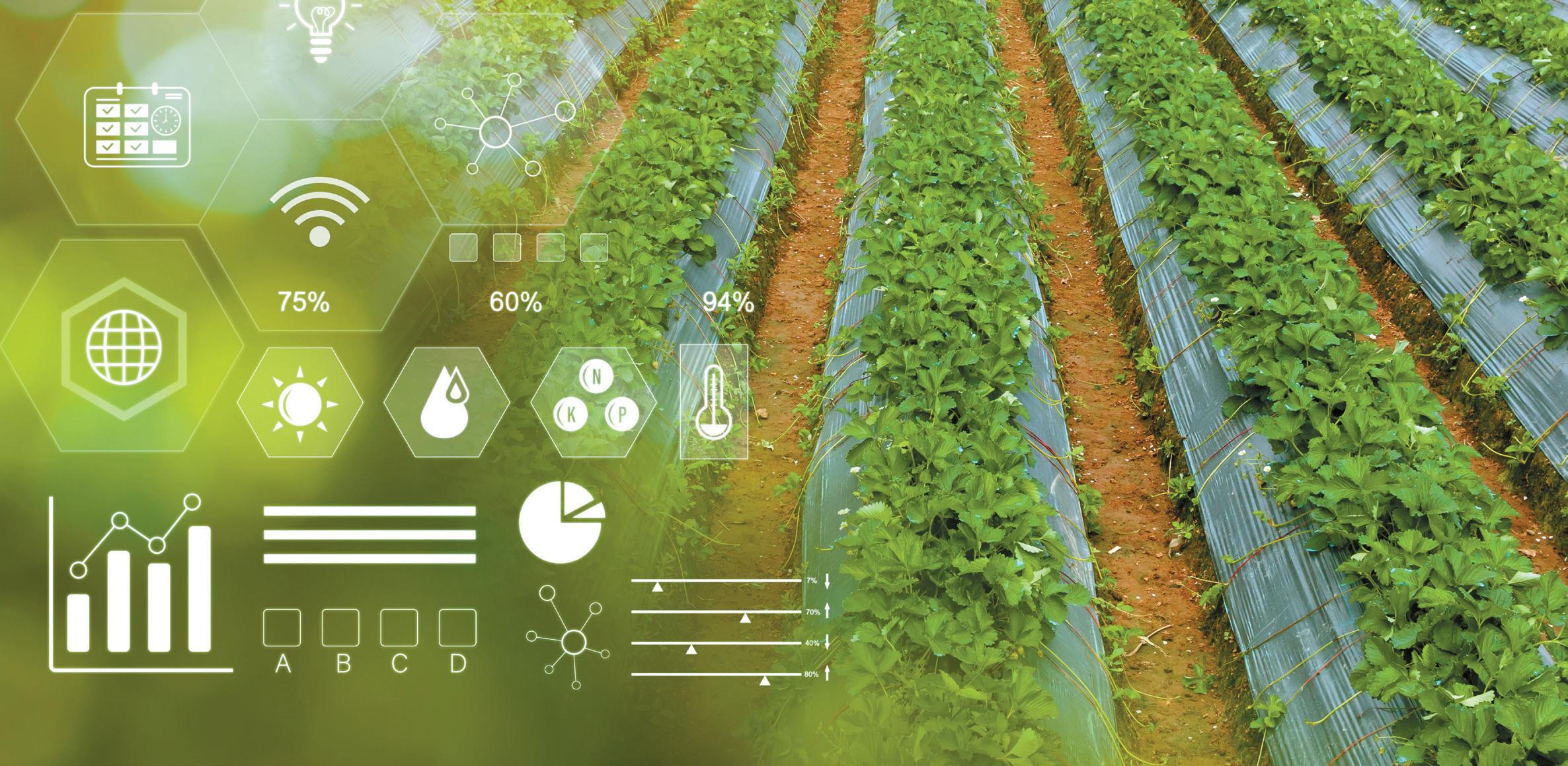
By Md. Sayemul Islam & Paul Nugent, MSU Precision Ag Asst. Professor
In MFU Magazine’s Spring magazine, we introduced the concept of precision agriculture and our efforts to establish a PA program at Montana State University. PA represents a revolutionary shift in agricultural practices. By harnessing advanced technology, PA empowers farmers to optimize their operations through data-driven decision-making. The major PA technologies available, such as auto-steering guidance systems, variable rate application of herbicides and fertilizers, and tools to monitor in-season crop health and end-of-season yield and quality, promise a wealth of benefits. These include enhanced management of agricultural inputs, reduced production costs, and even positive environmental impacts. The United States has recognized this potential and is actively promoting PA adoption. However, the key question remains: To what extent have American farmers embraced these transformative technologies?
Our current research is dedicated to answering this pivotal question and understanding the factors influencing American farmers’ decision to adopt precision agriculture. We are analyzing the results of the 2022 Census of Agriculture, which for the first time published county-level data on the adoption of precision agriculture in the U.S., allowing us to study adoption variability. We also aim to delve into the economic benefits associated with these innovative practices. Through this research, we aim to provide a comprehensive understanding of the role precision agriculture can play in the future of American agriculture.
Our preliminary analysis of COA 2022 data reveals that we are still in the early stages of national adoption of precision agriculture, with most counties well below the 50% adoption mark. This indicates that there is a significant opportunity for growth and development in the field of precision agriculture on a nationwide scale. The data also highlights the significant regional disparities in PA adoption. The Midwest and neighboring states are leading the way, with some
counties boasting an impressive 56% adoption rate. However, other regions are significantly lagging, with adoption rates as low as 0.26% (Figure 1). The factors contributing to these disparities, such as geological factors, cropping patterns, irrigation advantage, and farm size patterns, are complex and require further investigation.
Montana presents a particularly fascinating case study. Here, we observe a phenomenon of “clustered adoption,” particularly within the Golden Triangle counties and the Northeastern corner of the state. Notably, Liberty County emerges as a leader, with a 50% adoption rate. However, there are anomalies, including Cascade County.

Despite a high concentration of PA service providers in Great Falls, Cascade County exhibits a surprisingly low adoption rate (Figure 2). This begs the question:
Why are farmers embracing PA in neighboring areas yet not in Cascade County?
Currently, we can only speculate on this cause. Potential explanations may lie in the different agricultural practices or local farming culture. When currently undefined, the low adoption rate in Cascade County, despite service providers, indicates a hidden factor within the county that is delaying the adoption of PA technologies. These anomalies will guide our future research. We aim to collaborate with farmer groups and local extension services in outlier counties like Cascade or Liberty to gain valuable insights into the decision-making processes surrounding PA adoption. Such collaborative efforts can help illuminate the specific challenges and opportunities faced by farmers of various sizes and locations, ultimately leading to the development of targeted policies and support structures that promote the wider adoption of PA technologies.
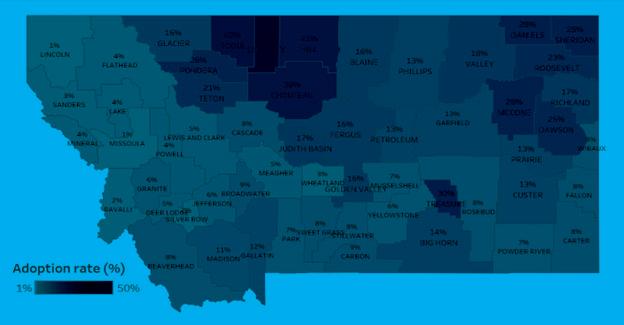
Beyond regional trends, our analysis also revealed a fascinating pattern when examining farm sales categories. (Figure 3) shows a clear correlation between farm sales and adoption rates, illustrating that farms with higher sales have higher adoption rates. Additionally, it demonstrates the relationship between farm size and adoption rates. Furthermore, larger farms appear to be increasingly adopting precision agriculture. This trend, however, varies slightly for the largest operations. Several factors might explain this deviation. Extensive farms may have already achieved a high level of optimization, rendering the additional benefits of PA less substantial. Implementing these technologies across vast areas could pose logistical challenges, leading these giants to prioritize alternative cost-cutting strategies. Data management concerns and a potential tolerance for greater yield variability within large-scale operations might also be at play. Additionally, the unique characteristics of multigenerational farms warrant consideration. With their potentially longer planning horizons and established knowledge base accumulated over generations, these farms could approach PA adoption differently. Perhaps they are more inclined to invest in these technologies due to the potential for long-term benefits and a sustained focus on efficiency. It is crucial to acknowledge that data limitations might prevent a definitive explanation for this observed trend.
While our current understanding of PA adoption in Montana is valuable, it has limitations. We are working to address these limitations at Montana State University’s precision agriculture lab. Our proposed research will incorporate widerscope data and a broader range of explanatory variables, including county-level demographics and GDP, targeted regional studies, economic efficiency analysis, and robust econometric modeling. By employing these methods, we will gain a more comprehensive and dynamic understanding of PA adoption in Montana and the U.S. This deeper knowledge will be instrumental in crafting effective policies and investment strategies to unlock the transformative potential of PA for a sustainable and efficient future of American agriculture.
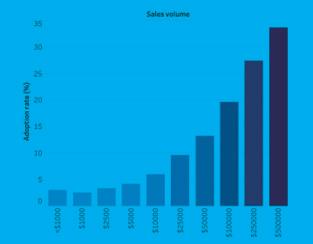
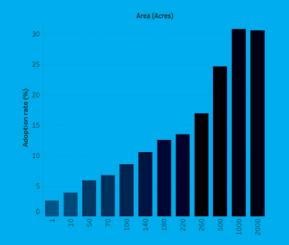
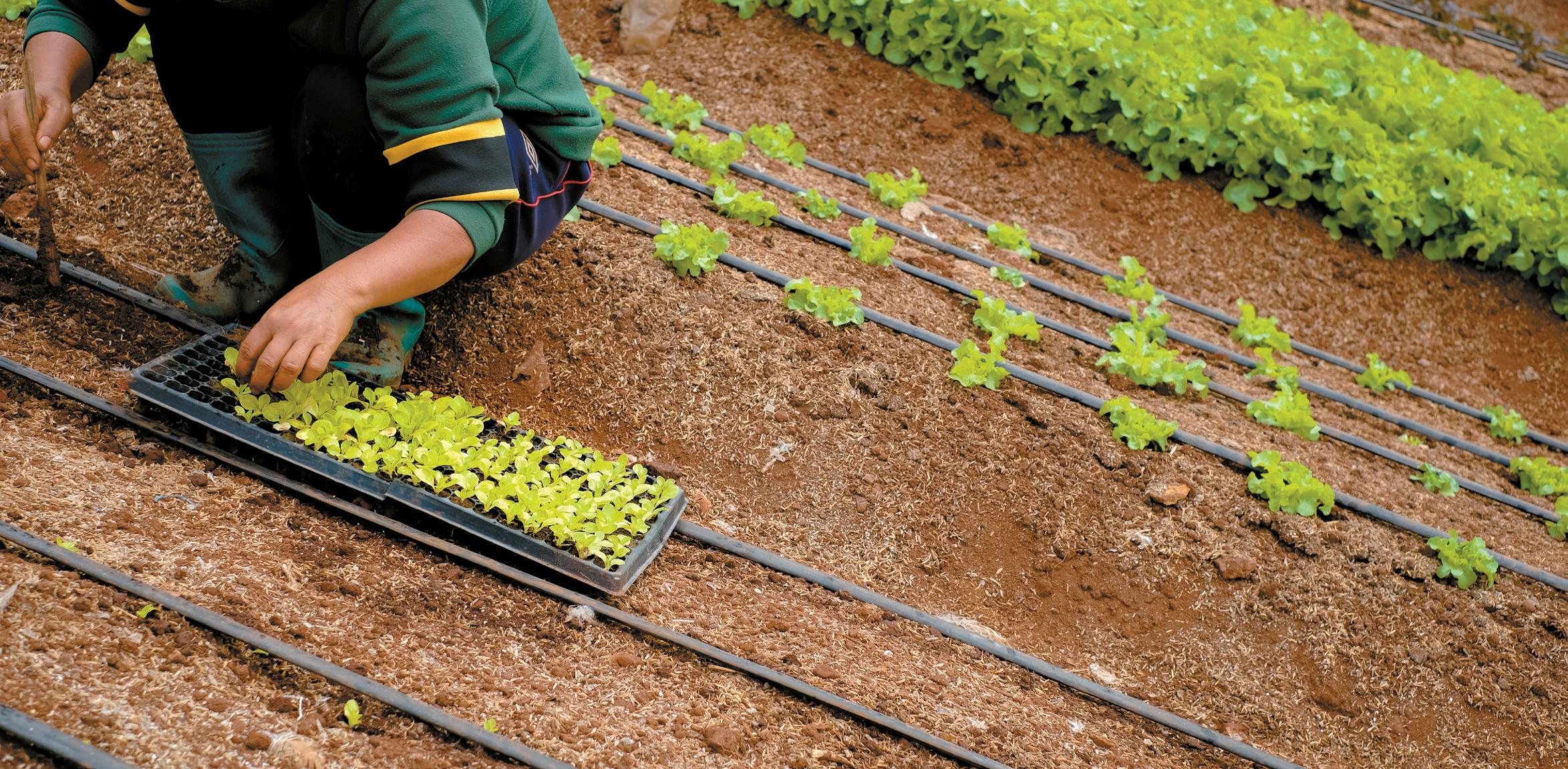
By Jasmine Krotkov
Weeds are nothing but plants growing where you don’t want them to. Plant pests and diseases are, likewise, just critters and organisms living their lives where you don’t want them to. I’ve never met one that was malicious. Even so, we often have hair triggers when it comes to spraying pesticides.
I’ve been gardening organically for decades, and yet, when I see whiteflies in my greenhouse, my first instinct is to spray them with soap spray.What I’ve learned through trial and error is that it’s often more effective to open the greenhouse doors and let the wind and beneficial insects in to feast on the pests.They won’t get every single whitefly, but it saves me a lot of spraying.And leaving a few whiteflies around invites the beneficial lacewings and ladybugs to set up housekeeping. That way, they’re available to prevent the next population explosion of whiteflies.
There is a wide variety of organisms in any garden or farm, only a few of which are pests. Many are beneficial, decomposing organic matter (such as dead plants), pollinating crops, killing pests, providing shelter or food for natural enemies of pests, or performing other useful functions. Protecting our vegetables and fruits from pests with minimal use of pesticides is not as hard as you might think.
Integrated Pest Management programs can help.The USDA definition of IPM is:“a science-based, sustainable decisionmaking process that uses information on pest biology, environmental data, and technology to manage pest damage”. Alternatives to pesticides include biological control, resistant varieties, traps and barriers, crop rotations, solarization, tillage, and many other cultural practices
The key to successful use of IPM methods in small farms and gardens is knowing when and how to apply a spectrum of techniques both for prevention and control of problems.The real purpose of IPM is not to kill pests, but to give the crop plant enough protection to allow you to harvest an acceptable quantity and quality of food.
As Joni Mitchel sang:“Gimme spots on my apples, but leave me the birds and the bees, PLEASE!”
The cheapest and most reliable way to avoid pest problems is to provide an environment that discourages pest activities and reduces plants’ susceptibility to damage.That can mean planning the layout; building up good, loamy, water-retentive soil with good drainage; water management; and choice of crops and varieties.As they say, prior planning prevents poor performance. Even with the best planning and management, however, pests and diseases can become a problem.When they do, there are three things to keep in mind: knowing what the pests are, watching their population levels, and knowing how to control them.
Misidentification of pests accounts for more failures than most people realize.When you see an insect, weed, or plant disease, identify it. Don’t guess, rather ask your county extension agent or an experienced and trained gardener for their opinion. MSU has a wealth of resources for urban or horticultural IPM, with insect, disease, and weed identification fact sheets all free of charge: https://urbanipm.montana.edu/resources/index. html
One of the most important features of your IPM program is going out into the field or garden on a regular basis to systematically check for pests and damage. Inspect your vegetable plants at least once a week for signs of pests and pest damage.Walk through the furrows, turning over leaves on every few plants to look. Keep written notes of your findings, recording the date, time of day, stage of crop development, and any unusual weather conditions or cultural practices such as irrigation or pesticide application.
If you do something to try to correct the problem or kill the pests, keep a record of what you did and the results. Equipment for your monitoring program should include a notebook, an 8-10 power hand lens (or magnifying app on your phone) for viewing small arthropods, and small plastic bags for keeping samples to take back for identification.A beating sheet can be useful for sampling various insects that are easily dislodged by shaking.You should also have a thermometer and a rain meter in the garden so that you don’t have to rely on your memory for how hot or dry it’s been.
3.Tolerance levels of control action guidelines
A certain number of pest individuals or a certain amount of pest damage is tolerable, but how much? It depends: how much cosmetic damage (spots on your apples!) is okay for you? How easy is it to control the pest in question? Least toxic pest management techniques can take several days to provide control, so you may have to allow more lead time.When in the plant’s growth cycle the pest occurs is another variable to consider. Seedlings are particularly vulnerable to competition from weeds and damage from insects. Plants that are stressed from heat, drought, or poor soil aeration will likewise require more pest control intervention than those that aren’t stressed.
Most of this is common sense, and you already do most of it in an offhand way.The key is to keep checking, keep records, and keep on having fun!























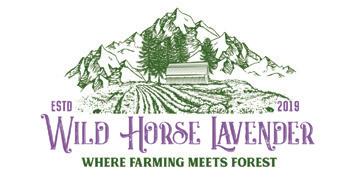

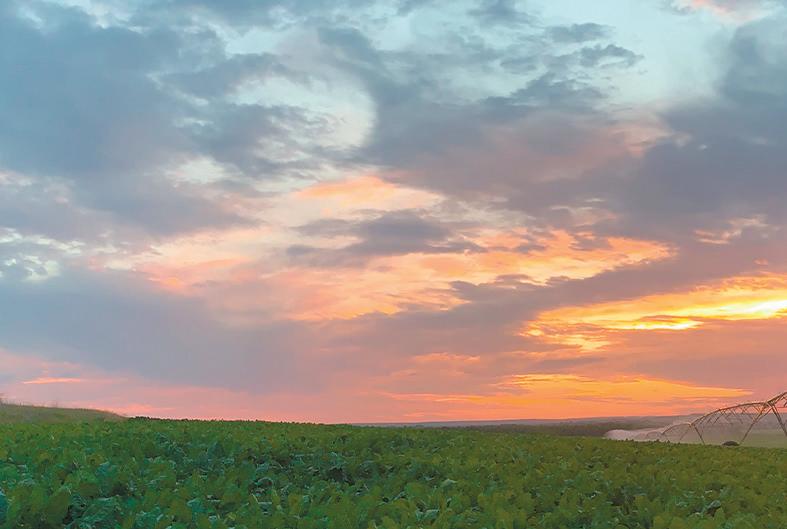


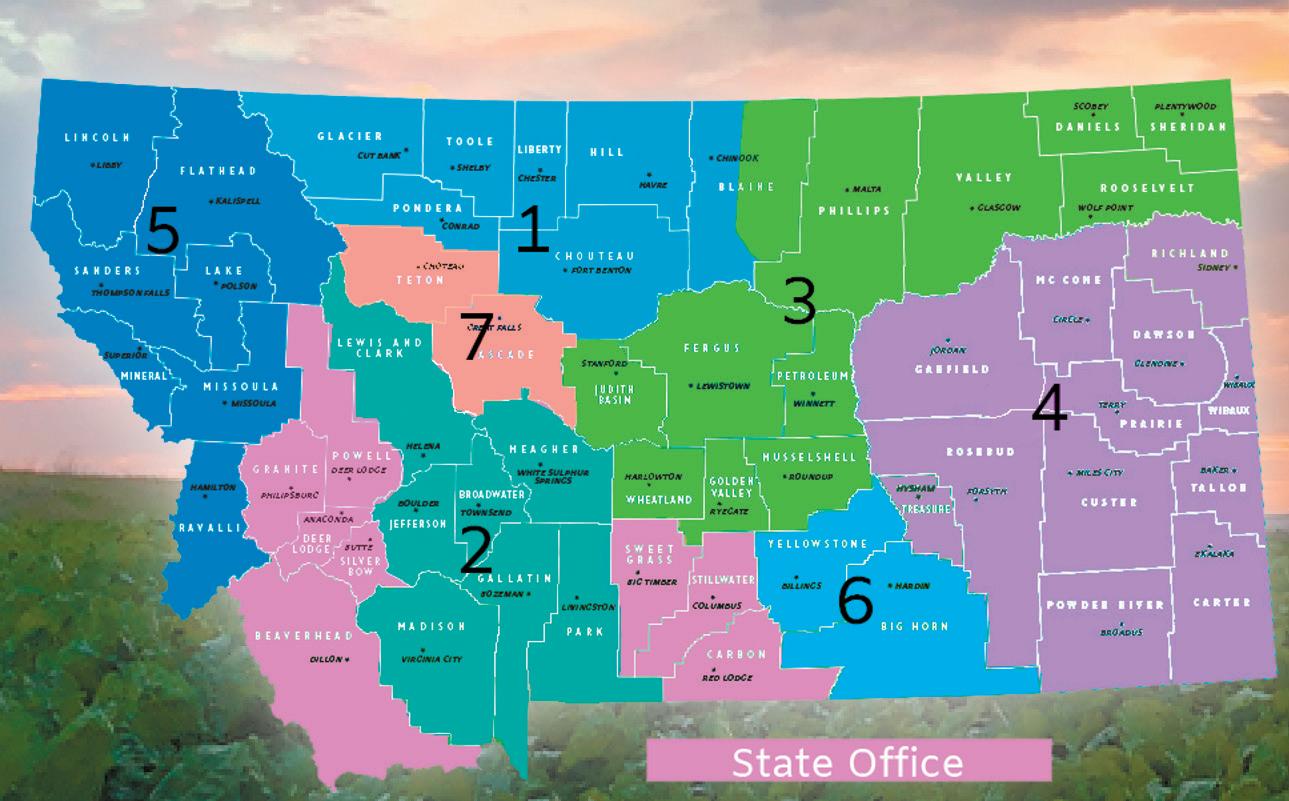


I have been blessed to have a rich, full agricultural life. I come from a long line of farmers, loggers, and ranchers. My great grandparents were loggers, cattle ranchers, and sheep producers. My grandparents were wheat farmers and cattle ranchers in Oregon. My parents were involved in logging, sheep, and agricultural education. I had the honor and hard work of having sheep, gardens, and greenhouses. I have always known where my food came from and been thankful for the work and effort that went into producing, processing, and marketing it. I have worked hard to instill this same knowledge in my own children. As a family we are at least four generations of FFA and 4-H members and leaders helping to pass knowledge and appreciation of food, fiber, and natural resources on to future generations.

One weekend, my very young daughter sat at my school petting the chicks and telling them they were cute. I could foresee the future when it came time for the barbecue and the tragedy that I needed to ward off. After explaining where our chicken dinner had come from, I thought she might have gotten the message. The next weekend, my daughter sat petting the chickens, but the words she was telling them had altered a little. She said, “You are so cute, but one day, you will taste really good for dinner!” I knew she understood.
It is concerning that the majority of U.S. citizens nowadays are three generations distant from agricultural practices. Many individuals are unaware of the origins of their food or the extensive efforts and resources required for its production, processing, and distribution. Deceptive labeling, the concentration of the food supply chain in the hands of corporations, and the continuous exposure to often inaccurate information further complicate the understanding of agriculture and the food supply sources. Organizations such as Montana Farmers Union play a vital role in ensuring that the voices of those in agriculture are acknowledged and comprehended.
Montana Farmers Union plays an important role in educating producers and consumers. I am excited to be a part of the voice of agriculture!
Ambassador Jodi Koterba- Teton-Cascade
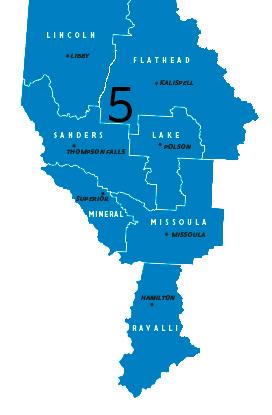
Did you know Montana Farmers Union has a new podcast?
I had a completely different article written, but after listening to the recently relaunched Lunch & Learn podcast from our new education associate, Jody Koterba, I was inspired to go in a different direction. The “About MFU,” podcast featured Walter Schweitzer and Rachel Prevost and covered the history, philosophy, and ways to be engaged with MFU. Please tune in, it is worth the listen.
I was first introduced to Montana Farmers Union through Women’s Conference. It was February of 2022, and we had just finished kidding 20-plus goats. I was tired, isolated, and felt alone. Rachel Prevost, and her incredible spirit, greeted me at the front desk for registration, and I limped my way to my room. Later that evening Walter Schweitzer kicked our weekend off with his MFU president’s address. Throughout his talk, I held every tear of the last year of hardship tight in my throat. No one in the room knew we had lost our farm to development, and that we had sold the cattle to make the move, nor did anyone know it took us 30,000 miles and 23 truck loads to move the entire ranch. Walter addressed us in that space of women in ranching, farming, and rural communities, and we were not just seen, but cared about. There was something in his words that reminded us we were not alone, but even more than that, there was a fight to be had, and Montana farming and ranching and rural communities was worth the fighting.
I called my husband that evening speaking through the last 10 years of tears. Tears from the last eight of those years of the water being turned off, while we simultaneously watched 4,200 homes go in. Tears on our shoulders from our neighbors when their wells went dry. Tears from the day the county surveyor left after his tape measure landed 35 feet in our front room for an I-15 interstate expansion project.
My husband listened patiently, his multi-generational agricultural loss kept private and steadfast. This was not the only farm he had lost. “We either put our heads in the sand, or make a stand,” he said.
We chose to make the stand, becoming engaged members of MFU.
For our family, Montana Farmers Union is more than hope. It is farmers and ranchers working together to do the real work on the ground to make the future of agriculture a little stronger every day.
Please be in touch with the state office, or your local ambassadors. We are here to make the difference. Ambassador Carissa McNamara - Flathead
YELLOWSTONE BIGHORN -
Hey, hey, everyone!
Happy Summer! I’m hoping everyone is just as excited about farmers markets popping back out as I am! If you want to know the dates, times, and locations of farmers markets near you, I would be more than happy to give you one of the brand new Local Food Guide from Abundant Montana to help get you connected to producers close to you.

In Yellowstone County: We have all the 4-H kiddos getting ready for the Montana Fair at Metra Park. This year the dates are Aug. 9-17 with a schedule including everything from animal shows to ice-cream stands, so make sure to drop by, say hi, and get yourself a cone!
We had an MSU Summer Field Day last year in Huntley at the Southern Ag Research Center, but from what I’ve learned from College of Agriculture & Montana Agriculture Experiment Station in Bozeman they have that one on a bi-annual calendar, so we dodged a bullet with those mosquitoes this year! MSU Summer Field Days are a great way to learn about the crops in the area, what they have had success with so far, and what they are testing out for new and existing crops. Very educational events, and I’d strongly recommend this event for next year. We love supporting these and would be more than happy to have some members and interested people joining us there.
For Bighorn County: I had a booth at the Crow Health Fair in May. It was so much fun speaking with people who wanted more information on what we do, who we are, and what we represent as a community. I even had a few members drop in and say hi! The Big Horn County Fair is going to be July 23-29 this year with the theme of Tiki Lights and Country Nights.
As we move forward with Ladies Who Ag, membership meetings, and youth Day Camps please remember everyone is invited – whether you are a member or not. While we love it when folks become members, learning about agriculture and helping family farms and ranches is our top goal. Building community ties within the regions is our best way to do that. So, I would love to both hear from you and see you at these upcoming events.
Enjoy your summer and stay cool out there!
Ambassador Skylar Williams - Yellowstone Bighorn
Continued on next page
Continued from previous page

The summer months in the south-east area of the state might be dusty, mosquito-filled, and exhausting, but I have always delighted in how the summer work makes me feel purposeful. There rarely is an excuse not to do anything – just drink more water and you will be fine! Everyone is busy with family time, summer goals, to-do lists, upkeep, and catch up. It could all become very overwhelming very quickly if you don’t keep ahead of it.
My summer plans include hosting kids day camps in Forsyth and Broadus, Ladies Who Ag programming for most of my counties, attending fairs, networking through EMRA and MSU events, and helping to get the Richland County Local up and running. Listing it out makes it seem rather easy to accomplish, but I know that the driving time and hot days will quickly sap a lot of my energy. Which is why it is important for me to remember the overarching purpose that energizes me to do all that. For me, that purpose is to provide as many community members and producers as possible with information and resources that empower them to be successful.
I believe that the most effective people are the ones who make their own educated decisions. Education, one of the Montana Farmers Union founding pillars, is intertwined around what I work towards. Any legislative or cooperative action that members take stems from their educated decision on a specific topic. I might not know everything myself, but I know who to connect you with who does know more information. I might not have a degree in elementary education, but I know the intrinsic value of teaching kids about the awe-inspiring natural world will help encourage more young people to participate in and support agriculture.
The producers in my region who are working hard this summer have a limited amount of free time and cannot afford to lose it. This summer, as I travel around my 12 counties, I want to make sure I do not waste anyone’s time, because there are only so many summers left to get stuff done. Being purposeful means I need to fine-tune my programming and outreach, so that both MFU and community members walk away with new, pragmatic information they can apply.
I am looking forward to my work this summer because I know I will be fulfilling my purpose as an MFU ambassador! Ambassador Eleanor Dutton - Eastern MT
CENTRAL MT -
Work-life balance for producers whose work is a lifestyle can be quite complex, as the lines between personal life and professional responsibilities often blur. This lifestyle that involves working closely with livestock and family offers a degree of independence and self-reliance that many find fulfilling, as they are directly responsible for their livelihood and the well-being of their property and animals. Achieving balance in such scenarios requires unique strategies. Here are some valuable pointers I’ve learned and that MFU helps facilitate.
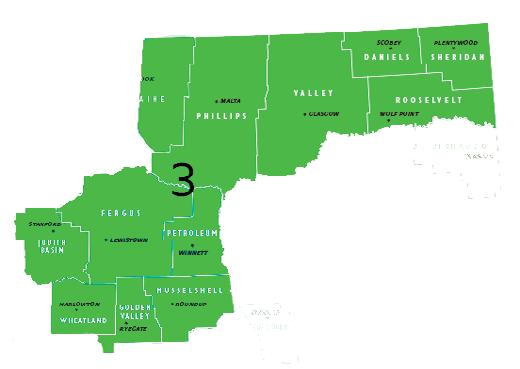
Integrate Work and Personal Life. For many producers, completely separating work from personal life is unrealistic. Instead, finding ways to integrate the two can be more effective. This might involve incorporating family and friends into work events, such as branding or tailgate picnics lunches with the family in the field when seeding, haying, or harvesting. Sometimes work on behalf of the operation isn’t in a field, but rather advocating for agriculture. The annual NFU Washington, D.C., Fly-In is coming up. If you are interested in making your voice heard in the democratic process, join a group of MFU members during the visit to D.C. this fall. Contact your Ambassador for more information.
Prioritize Self-Care. The physical nature of ranching helps maintain a healthy, active lifestyle. The demanding work can improve physical fitness and mental health, leading to overall well-being. Even when work is enjoyable, it is important to take time for other activities that promote mental and physical well-being. Regular exercise, adequate sleep, and healthy eating are essential. Engaging in hobbies that are unrelated to work can also provide a necessary mental break. For example, throw some horseshoes before supper or shoot some hoops with the kiddos. Montana Farmers Union has a member benefit for mental health. It is the Farm Family Wellness Alliance mental health and wellness service. More information about this can be found on our website.
Set Clear Boundaries. While it can be challenging, establishing boundaries is crucial. This might mean setting specific work hours or designating certain days off where work-related activities are minimized. For example, reserve one evening a week in the summer to enjoy an outdoor sports activity. And speaking of sports, do not forget about the awesome MFU member discount at Cabela’s and Bass Pro shops when shopping for your sporting goods.
The passion for ranching and the joy it brings daily can be a significant source of personal fulfillment. However, achieving work-life balance as a producer whose work is a lifestyle is an ongoing process. I hope you will take advantage of some of the benefits and resources MFU provides to make finding balance easier.
Ambassador Mary Jenni - Central MT
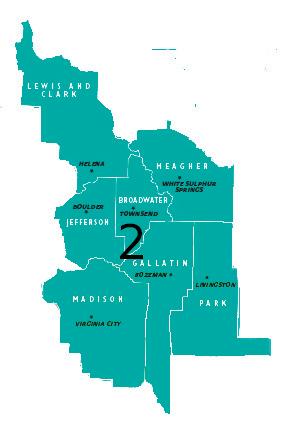
Efficiency – friend or foe? Is being the most efficient the best thing for our landscapes, our farms and ranches?
The first thing I tend to think about when pondering these questions is irrigation. On our ranch we have pastures and grass hay fields which are flood irrigated. A person may question the efficiency of flood irrigation versus that of wheel lines and pivots. I’ve come to realize there is the right time and place for most agricultural practices.
So, to answer the question of efficiency, I would reply: “What do you value, and what are your goals for your farm/ranch?”
With flood irrigation on our ranch, I can attest that our pastures and fields stay greener longer, then continue to grow well into late summer allowing us to stock-pile grass for fall and winter grazing. Our creeks maintain more adequate flow throughout the summer and fall due to subirrigation from the two times we flood irrigate – early spring and late summer. By flooding our fields and pastures, we are helping recharge the aquifers and increase groundwater levels, which in turn helps our neighbors adjacent to us and a few downstream.
I also see improvements in wildlife habitat because of flood irrigation. Multiple species of birds are prevalent on our ranch throughout the spring, summer, and fall including egrets, ibis, eagles, owls, hawks, sandhill cranes, swans, ducks, and pheasants. Brown trout spawn in one creek that flows into the Missouri River. The FWP uses this spot to monitor and study the fish species in our creek, especially the brown trout.
Another efficiency topic I ponder, and we are experimenting with, is fertilizer. We have done many soil and forage tests over the years which led to experiments with different types of fertilizers applied at various rates. This year we are exploring and utilizing biological fertilizers instead of chemically derived ones, Vermicast in particular. Vermicast is made up of organic matter that has been broken down by worms; the castings are high in nitrogen, phosphorus, and potassium, making them an excellent natural fertilizer. We believe the fertilizers will “wake up” our soil due to the increase of good bacteria the fertilizer provides, leading to healthier, more robust plant growth, which in turn will increase the nutrient content of our forages providing better quality feed for our grass combines, AKA our cattle!
I could continue down this rabbit hole for much longer, but space is limited. I would love to hear members’ thoughts on this topic – let’s get together over lunch or coffee or at your farm/ranch!
Ambassador Samantha Ferrat - Missouri Headwaters
Graduating is among the most exciting but terrifying times in any young person’s life. All throughout college, I thought I knew exactly what I would do and where I would live, and then the world as we know it stopped with the pandemic. For a while, I felt lost, but my one constant was Montana Farmers Union.
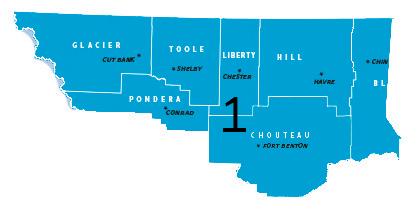
I started with Montana Farmers Union as a camper and grew to be a counselor. I was nominated as a delegate for the National Convention and asked to be on our state policy committee. Through all of the turbulence in my life at that time, such as getting into the cattle business, my mother’s battle with cancer, and trying to figure out what I wanted to do with life again, Montana Farmers Union consistently invested in me. They continued to reach out about policy opportunities, and then, when the time was right, job opportunities. Now I work with MFU, bringing what I’ve learned about leadership and education from MFU to my role as your Membership Ambassador.
Since this time of uncertainty, Farmers Union has just continued to grow through the great work of my fellow ambassadors, providing different ways to continue your education and giving numerous opportunities to grow within MFU. We can connect you with other MFU members and ag professionals through various MFU committees, as well as with events aimed at nurturing your growth. Our state-wide events are planned with our members in mind to make sure that the materials and speakers we provide are valuable to our members.
One of the parts of graduating I struggled with the most was not being around people as much anymore, but knowing there was someone I could talk to from Farmers Union to continue my involvement was always incredibly reassuring, as well as having the various events that Farmers Union organizes has helped with that. Even though the chapter of college has closed for you, it doesn’t mean that your journey of education has ended, and we at Montana Farmers Union intend to make sure that you can continue to grow. If there is ever a topic that you would like to have a workshop on or learn more about, please reach out to your local ambassador. We would love to set something up!
Ambassador Jeri Copenhaver - Golden Triangle
Montana farms and ranches add event facilities to boost income, promote their operations to customers
By Nick Gevock
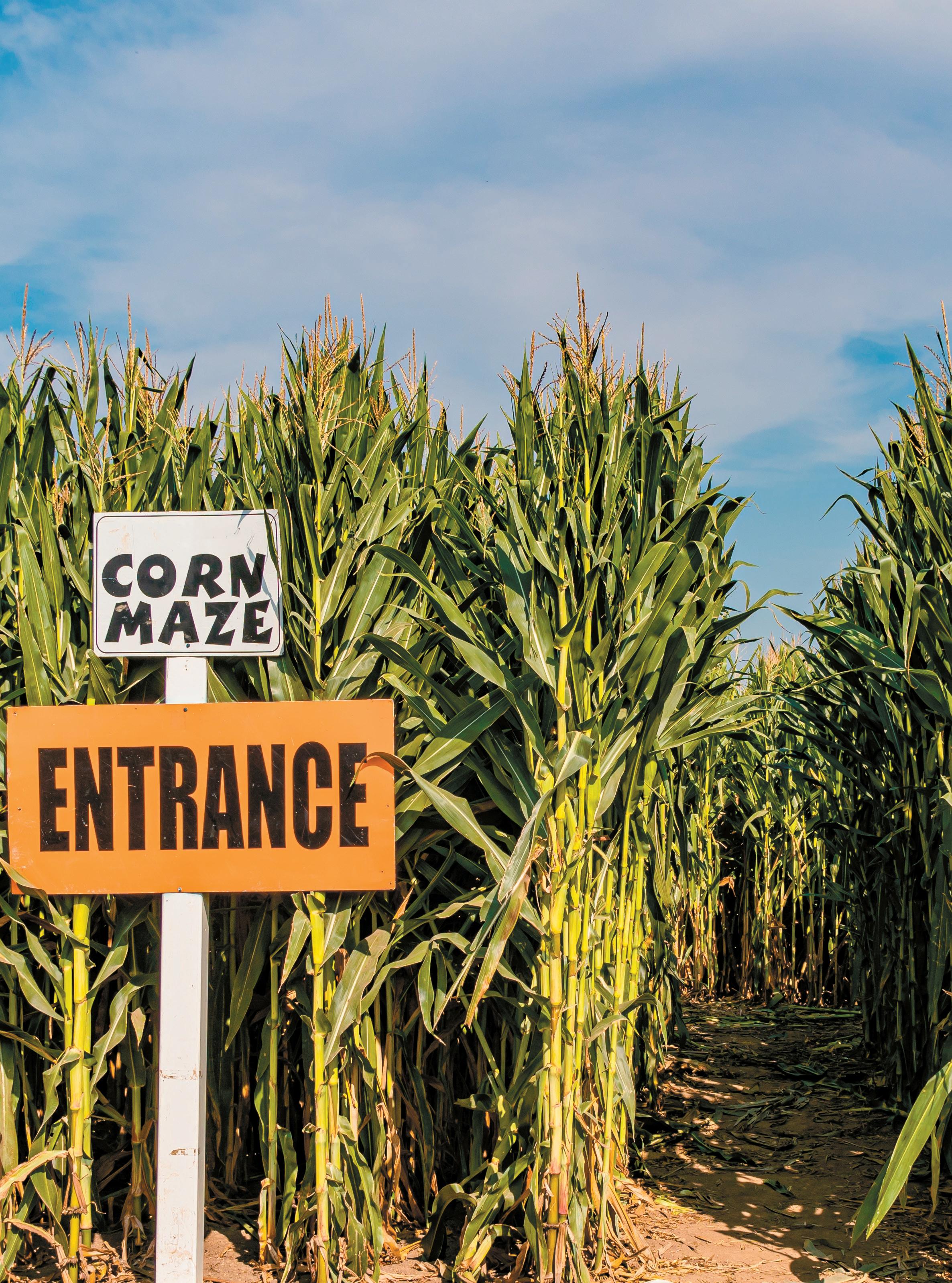
Tricia and PJ Kimmel saw the chance to turn a historic dance hall set on the wide open prairie of North Central Montana into a marketing tool for their beef.At the same time, they saw a chance for a badly needed community center in the tiny town of Turner.
So the couple plans to move the old structure from its historic home on a ranch into Turner and restore it as a community center that’s open to everyone for multiuse.They are also planning to build a structure next to it with accommodations and a multipurpose area.
“We just want to have a place where kids can mess around and learn about music, or other things,” Tricia Kimmel says.“Our seniors need a place to gather, and we don’t really have a place to get together.”
The dance hall has a deep history in Turner. Settlers in the early 1900s built the hall as a community building venture, and in the 1990s the local Lions Club did a great deal of work on it.Tricia said it’s ready to be moved onto a lot they purchased in Turner, and once there, while it will need work, it won’t take long to be up and running.
And while she likes to foster a sense of community,Tricia Kimmel says the project is very much a business decision.A couple years ago she and PJ penciled out their cattle operation and decided that staying in a traditional cow-calf operation wasn’t working. They are building a direct-to-consumer model to fetch a higher price for their animals.
The dance hall and future building next to it fit into that business model. It’s a serious investment, one that when it’s all said and done will cost more than $250,000. But Tricia Kimmel says they see it as a long-term project to build their brand.
“In agriculture, we don’t get to name the price for our product, and we wanted to get to say what we need to get from our cattle,” Tricia said.“If we can be that marketer, and build those relationships between our customers and us, we can get a better price for our cattle.”
Tricia said they crunched the numbers, and determined if they can sell 120 head of cattle to customers at the price they need to get, they will earn as much as running 700 mother cows.And they needed to do it. Like so many other ranches, the drought in recent years has forced them to scale down their herd.
They’re working to build brand loyalty to their beef by having their customers out to the ranch to learn about their operation, how they work to conserve the land, and how sustainable grazing is done.The agritourism ventures on the Kimmel Ranch will help build their brand, and at the same time bring in some extra income.
In a state like Montana, where many people have four jobs, farmers and ranchers are no different. In cities people call it their “side hustle.” For ag producers, it helps to have additional income to supplement the crops and livestock that are produced on a family farm and ranch. In fact, it’s becoming more and more essential.
If anything, it’s even more important for farmers and ranchers to add additional income.When you’re producing crops and livestock, often the paychecks are once a year. Most people outside agriculture get a steady paycheck every couple weeks, or at least monthly.
The extra income for farmers and ranchers can help make payments on equipment, cover insurance, and help with monthly bills.And like any business, it’s essential to earn extra income from the investments and assets of a farm – the land, the equipment, and the facilities needed to keep a working farm running.
Rachel Prevost, MFU’s government affairs director, said they are seeing more and more farmers and ranchers who are diversifying to bring in extra income. Like the Kimmels, producers are using it both to build community by hosting events, but also to build a deeper connection with customers.
“I hear a lot about it in terms of income diversification for ag operations,” Prevost says.“When we have event spaces, where a wedding or other event is hosted, it just gets more people exposed to agriculture, and it’s a great opportunity.”
At the same time, the trend of more and more event facilities on family farms and ranches offers a place in communities rural and urban for people to gather.They’re available for family events and ag-based learning, and in some cases offer accommodations to people who want to experience the farm and ranch lifestyle.
“Most people are so far removed from the family farm, they just don’t understand what it takes to raise an animal or grow a crop, but they want to put their money toward what they believe,” says Tricia Kimmel.“You cannot create more loyalty than having someone come stay on your ranch with you and help move cows, see how we raise our livestock.”
Erin Turner recognized the need in Missoula for a smaller venue to host casual events – things like kids’ birthday parties, baby showers, as well as classes for some agriculture groups like FFA and 4-H.
What she also saw in the slightly-oversized, two-car garage on the small farm she and her husband Jon operate just west of Missoula was a chance to educate their community on their operation, similar to the Kimmels.The Turners talk about the organic vegetables, the sheep, and other livestock they produce, and the practices they use to promote healthy soils.And, of course, the money that the facility brings in helps out during times of year that are slow for the farm.
“It’s just great income, especially in the wintertime when we don’t have the vegetables for sale,” Erin Turner says.“And any way that we can have the community connecting with agriculture and the farm out here, that’s really our mission.”
The Turners run a small farming operation – really small, by Montana standards at 18 acres. But their products are in high demand in the Missoula market – organic vegetables, beef, pork and lamb, and poultry for eggs and meat.
Erin Turner added that for an operation like theirs, just outside Missoula, it’s important to get people on the farm, connected to
Continued on next page
the source for their food, and hopefully turn those people into steady customers. In addition to the event space, the Turners also reach customers with their longstanding, popular Pumpkintober event.The multi-weekend event gets people to their farm to experience the animals, purchase pumpkins, and build community.
While farming basically in town has its challenges, in truth it’s an opportunity, too.They dubbed the building the “market garage,” and use it both to sell their products and host events. It’s worked out well, bringing in roughly one-third of their annual income and at the same time marketing their products.
“Being this close to town, our customer base is phenomenal,” she says.“Having the market garage and having random people coming in holding baby showers and birthday parties, it offers a great opportunity for them to learn about our farm.
“From a business point of view, it’s a brilliant marketing strategy.”
Storage building serves multi uses Other facilities on Montana farms and ranches started primarily as a way to have fun.
For Chris Fritz, it began as a corn maze on the family farm northeast of Kalispell. It was just a way to have some fun, invite the 4-H kids out after harvest in the fall.
They produce wheat, canola, peas, barley and hay, and raise some beef cattle. Fritz says the farm comes first, and as a result he built a 40-by-100 foot building to house equipment. But he couldn’t watch the building sit there and not put it to use while bringing in some extra income.

“We hosted a couple 4-H and MFU events there last year, and this year we have a couple weddings,” Fritz says.
The building is a work in progress. Fritz says they’re considering insulating it, installing solar panels, and making other improvements.They use it mid-September through October for the corn maze, and, like other farmers, are looking to get people to their farm to see what they do. Farming 300 acres in the Flathead Valley has its challenges, but Chris said it also comes with opportunities, and they decided to adapt.
“We could either complain about the people or do something that actually works for our location,” he said.“We started this just as a fun thing for the 4-H kids, and they had so much fun out on the trail, we said we’ll see if there’s interest in this.
“It was a way for us to get grocery money, so that not all the income had to go to the bank, because that’s how it is when you first start out as a farmer – there’s a lien on everything, you get a check, and it goes to them first.”
Prevost, with MFU, says that’s the theme she hears often.Agritourism and facilities on the farm are another way to help keep farms and ranches profitable.
“There are so many family farm and ranch operations where it’s become so hard to make it, and this innovation is bringing that revenue back,” she says.“We’re going to see more and more of that, to try to keep the family farm in the family.”
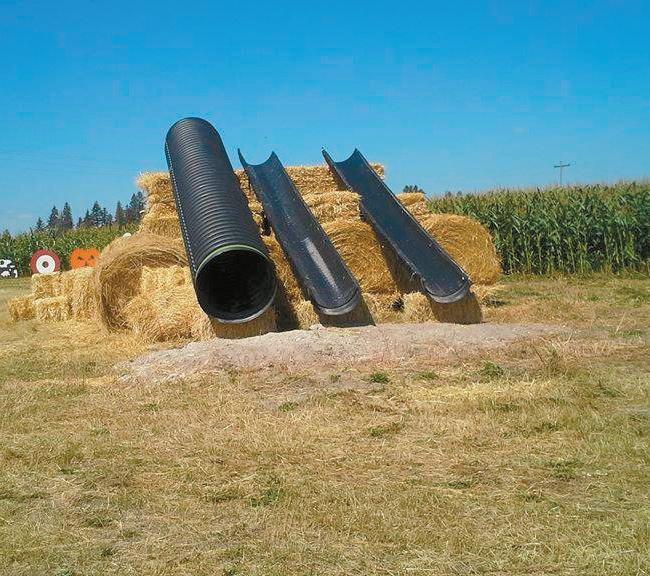
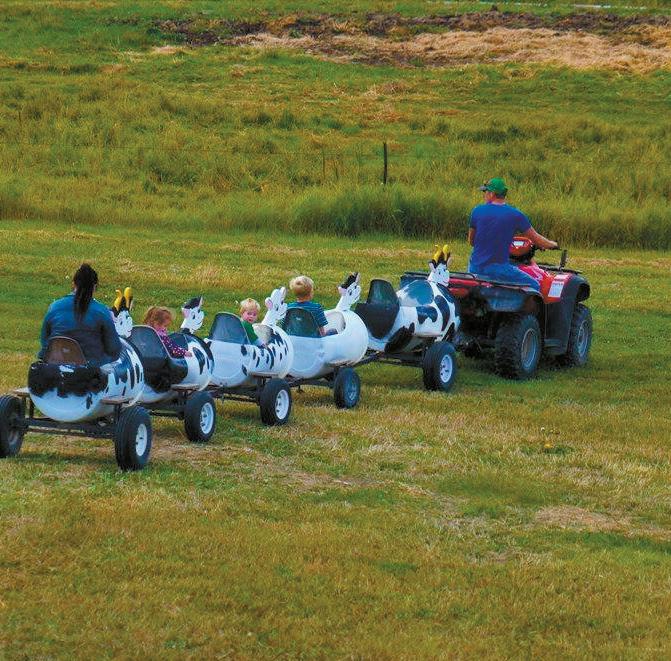
Montana Farmers Union recently awarded nearly $12,000 in scholarships to Montana students. The grassroots organization announced the scholarships in May as part of its commitment to education. The funding comes from MFU, the Montana Farmers Union Foundation, and several MFU Locals and supports both traditional and non-traditional students pursuing higher education. The scholarship program dovetails with MFU’s education efforts for people of all ages across the state, including offering Day Camps, Summer Camps at Arrowpeak Lodge, educational workshops, Ladies Who Ag programming, and more.
“The MFU Foundation exists to support agricultural education in our communities. We are excited to support so many talented, dedicated, and inspiring students to continue their educational paths,” said MFU Chief of Staff Matt Rains. “The knowledge to not only keep a farm or ranch operational and profitable but also ideas to revolutionize the future of our food systems start in the classroom. There is no better investment MFU’s Foundation can make than in the continuing education of our producers and their children.”






Reinhard William Bold (Big Sandy), $1,000 John Korsbeck Memorial Scholarship, $500 Choteau County Farmers Union Local
Lance Rutledge (Big Sandy), $1,000 John Korsbeck Memorial Scholarship
Grayce Siderius (Bozeman), $1,000 Bud Daniels Memorial Scholarship, $500 Flathead Farmers Union Local
Jordan Leach (Ledger), $1,000 Montana Farmers Union Foundation
Lauren Prevost (Lambert), $1,000 MFU Foundation
Lauryn Siderius (Kalispell), $1,000 MFU Foundation, $500 Flathead Farmers Union Local
Kyona Yeager (Fairfield), $1,000 MFU Foundation
Abigail Hutton (Conrad), $500 Montana Farmers Union
Shea Ostberg (Fairfield), $500 MFU
Layne Johnson (Westby), $500 MFU
Hannah Fussell (Ronan), $500 MFU
Michaela Hauk (Great Falls), $1,000 Cascade County-wide Farmers Union Local
Kenadie Berg (Billings), $250 MFU
Ashton Ulschak (Laurel), $250 MFU
Alyssa Robertus (Laurel), $250 MFU
Tammi Fladager (Peerless), $250 MFU
Cody England (Lewistown), $250 MFU To
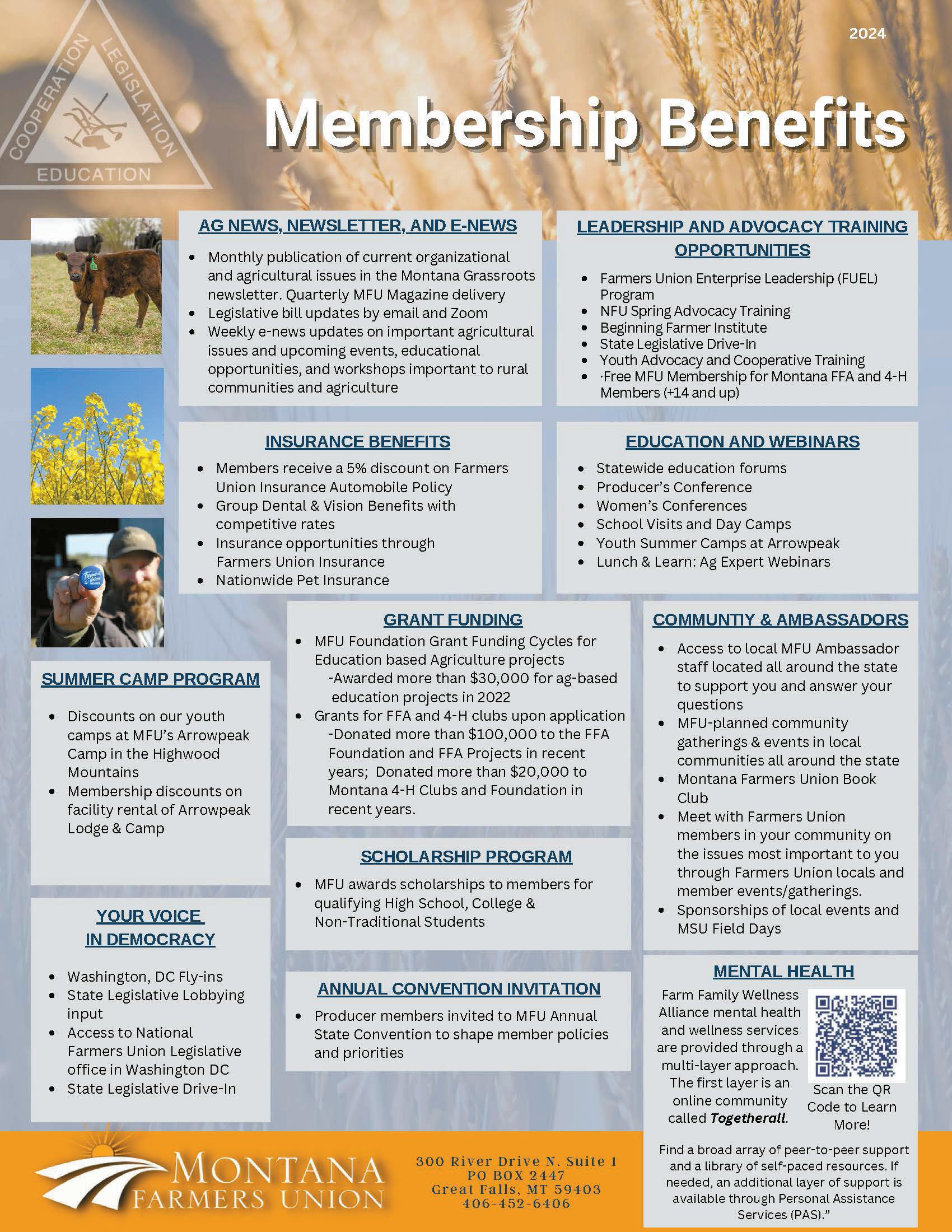


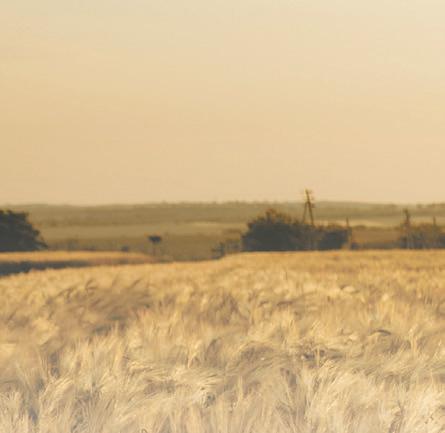




Jon Tester, U.S. Senator


A month ago, agriculture in Montana was dealing with more than adequate moisture. Now, at the time of writing this article in my neck of the woods, we’re dealing with drought. Thus is the life of a farmer in Montana.
Look, when it comes to working on farm equipment — anything with a motor — there’s a computer attached to any new machinery. When something goes wrong with that computer, and the tractor, combine, swather, or sprayer breaks down due to a computer glitch, we have to call somebody who has that computer program to fix it. That’s not right.
Time is money on the farm, and quite honestly, Montana’s farmers and ranchers cannot afford to not be able to repair our equipment when the only thing that’s wrong with it is a glitch in the computer.
When I talk to my neighbors across Montana, they tell me how frustrating it is to not be able to fix perfectly good equipment when the only thing that’s wrong with it is a computer glitch. It makes no sense to family farmers. It makes no sense to production agriculture. It makes no sense to rural America.
That’s why I’m continuing to push the Federal Trade Commission to ensure that Montana producers have the right to repair their own machinery. I’m proud of the work that the Montana Farmers Union has been doing as a partner in this effort, and we’ve got to keep up the fight.
It’s a fight for family farmers and ranchers, and I’ll always fight back against anyone who tries to turn their backs on folks in production agriculture.




In that vein, when it comes to raising top-quality beef, no one does it quite like Montana’s ranchers. And now that most of you have finished up calving, you deserve a fair and competitive marketplace to ensure both producers and consumers get a fair shake.
I’m a capitalist, but capitalism does not work without competition. For too long we’ve seen the big packers eat up more and more of the industry, forcing ranchers to take lower prices at the farmgate, and forcing consumers to pay higher prices at the grocery store. In fact, just four meatpackers control upwards of 84% of the market – and they’re working to control more of the market each year. That isn’t competition, and in the end, it’ll have negative effects on rural America, on our food supply, and on what the consumers pay for food.


That’s why the work that Montana Farmers Union does to support local, independent meat processors is so critical, and you should know that I’m fighting alongside you to inject some fair competition into the marketplace.
I am thrilled to see my Meat and Poultry Special Investigator Act is included in the U.S. Senate’s initial Farm Bill framework. This bill will finally put some teeth into the Packers and Stockyards Act by giving the USDA a special investigator with subpoena power to enforce already existing laws and it will secure fairer prices and better margins for Montana’s ranchers.
This is a big first step, and I’ll keep pushing to secure this bill – along with many more of your priorities – in the final Farm Bill text.
Moving forward, know that I’ll keep fighting against policies that don’t work for Montana’s family farmers and ranchers.
So please, keep sharing your ideas with me, and I’ll keep taking my cues from you.


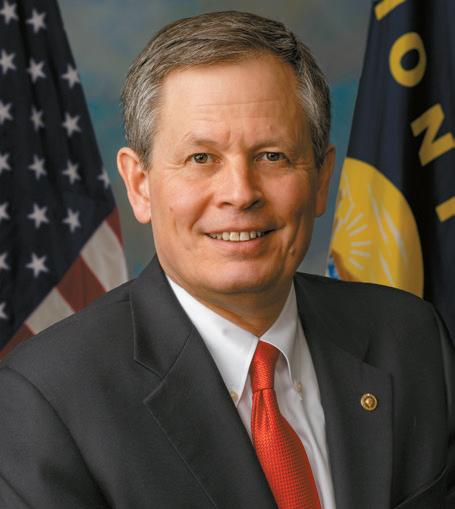
Steve Daines, U.S. Senator
Here in Montana, we take pride in being good stewards of the land and all of the natural resources, which includes both wildlife and agriculture. Implementing commonsense conservation strategies to promote a healthy ecosystem is critical to our Montana way of life. It’s the relationship between successful production ag and a healthy environment that keeps Montana’s agricultural industry resilient.
Across the Treasure State, countless ranchers rely on the Bureau of Land Management’s grazing allotments for their livestock, which provide important ecosystem benefits to these public lands ranging from wildfire mitigation to improved wildlife habitat. These public lands should remain accessible to the very people who are among the most essential stewards of our land, yet BLM Director Tracy StoneManning and her department continue to encroach on ranchers’ access.
In May, President Biden’s BLM announced its final Public Lands rule, which is a tragic overreach and poses a threat to our farmers and ranchers, who are the best in the world at protecting our precious land. Grazing, hunting, recreation and energy development have provided a longstanding balance of successful multiple use on our nation’s public lands, and I am fighting against the BLM’s new rule that will radically limit the public’s access and uses of the land. I joined a resolution with my Senate colleagues to repeal this heavy-handed and egregious attack on Montanans’ ability to use public lands and I asked Director StoneManning point blank at a Senate hearing to commit to ensuring that BLM’s rule will not push ranchers off their land.
Additionally, the Biden U.S. Fish and Wildlife Service proposed revisions in February to its Biological
Integrity, Diversity and Environmental Health policy that will prohibit grazing, predator control and other commonsense conservation practices within our national wildlife refuges. The Biden Administration continues to insert itself in the middle of longstanding beneficial management practices to further separate Montanans from the land we call home. I will continue to fight back against the proposed BIDEH policy change to ensure Montanans can continue to be the best stewards of the land and natural resources we’ve been given and keep federal bureaucrats out of the way.
I have long advocated for the delisting of the grizzly bear in the Greater Yellowstone and Northern Continental Divide Ecosystems because the current number of bears has far-surpassed the recovery targets set by the FWS. In May I questioned Interior Secretary Deb Haaland in a Senate hearing on the set recovery targets that she oversees, and she was not able to provide an answer. I shared with her that the target set for the Greater Yellowstone Ecosystem is 500 bears, yet the latest data from FWS shows there are 965. Similarly, the target set for the Northern Continental Divide Ecosystem is 800 bears, and the same dataset shows there are 1,138. Since the populations have surpassed their recovery targets, I urged Secretary Haaland to follow the science, delist the bears and return management to the State of Montana. We need commonsense management of the grizzly bears, and delisting the species will get us closer to achieving that goal.
Montanans’ way of life is deeply intertwined with a healthy ecosystem and abundant natural resources. It is often our agriculture producers who remain at the center of this delicate balance, as they tirelessly work to maintain ag productivity and steward the land. I am committed to ensuring our public lands remain a thriving habitat not only for wildlife, but also a vital resource for Montana ranchers. I look forward to working together to secure a path forward to safeguard Montana ag’s invaluable role in our state’s economy.



By Dr. Marsha Goetting, Professor and Extension Family Economics Specialist at Montana State University

A new magazine focused on Alzheimer’s and related dementias provides information and support for Montana’s farming and ranching families and the more than 22,000 Montanans living with Alzheimer’s.
Do you know a rancher or farmer who has developed memory issues? Perhaps the farmer is paying business bills twice or not paying them at all. Possibly the rancher is neglecting to deposit checks in the farm or ranch business checking account. If these behaviors sound familiar, you’ll want to share with them and their families the latest magazine from MSU Extension, Alzheimer’s and Related Dementias: Support for Montana Farmers and Ranchers.
While Montana has more than 22,000 people living with Alzheimer’s, there are no figures available about the number of agricultural producers who have the disease. However, a study in Iowa revealed people who identified as having long-term occupations in the agriculture sector had 46 percent greater odds of developing dementia than those who did not.

The magazine was developed because of the lack of information about Alzheimer’s disease and its impact on producers, specifically for Montana agricultural producers facing early to middle stages of Alzheimer's, their families, and family caregivers.The six articles in the first edition provide information that can make a positive difference in their lives:
1. Agricultural Occupations and Alzheimer’s: Potential Causes, Signs, and Early Diagnosis
2. Alzheimer’s and other Dementias: NOT a Normal Part of Aging
3. Progression of Alzheimer’s
4. Alzheimer’s and Caregiver Wellness
5. Communicating about an Alzheimer’s Diagnosis
6. Hope for the Future:Treatments or a Cure for Alzheimer’s?
Unfortunately, there is still a stigma attached to Alzheimer’s and other related forms of dementia. It’s not a person’s fault when their brain shrinks, and they can’t remember or perform chores like they used to.The magazine highlights that Alzheimer’s is a disease, not a normal part of aging.
Farm and ranch families across the state have shared their experiences about a family member who has Alzheimer’s, and some of their stories are incorporated in the articles. For example, one family realized Grandpa had memory issues, but they didn’t grasp the seriousness of it until the day Grandpa hopped on the combine and drove it down the highway as fast as he could go.After the Dad and the granddaughter got over their shock, they took after him.The granddaughter drove the pickup close to the combine so her dad could leap. Grandpa was surprised to see his son and asked if he wanted to ride with him to a nearby town.



Farmers and ranchers who are in the early stage of Alzheimer’s can complete legal documents to assure their financial, health, and legacy planning wishes are known by their families.After completing the proper legal documents, they can then focus on enjoying and appreciating life.
For example, one important legal document for the person living with Alzheimer’s and the spouse is a power of attorney for finances.As soon as family members suspect Alzheimer’s or if a physician has made an early diagnosis, a financial power of attorney should be completed.The person who has Alzheimer’s needs to sign the document while they have sufficient legal capacity.
A study by the National Institute on Aging found that 18 percent of caregivers died before the person living with Alzheimer’s. If you are the spouse of a person with Alzheimer’s, you need to plan for the possibility you could die first.You will want to consider how your estate plan could benefit your spouse and who would manage the funds for the care of your spouse.

The magazine articles are authored by professionals, including myself,Vicki Schmall, Emerita Professor and Extension Gerontology Specialist, Oregon State University; S. Dee Jepsen, Professor and Extension Agricultural Safe and Health State Leader at The Oho State University;Tiffany Hensley-McBain,Assistant professor; and Rebecca Brown, McLaughlin Research Institute for Biomedical Sciences, Great Falls.
The free magazine is made possible through funding from AARP-Montana,AgWest Farm Credit, University of Montana Geriatric Education Center, and the Western Extension Risk Management Education Center.
Already, the authors are developing Volume 2 that will be available in the fall, with articles exploring safety measures in the home, wandering, driving, helping children understand Alzheimer’s, planning for the cost of long-term care, and legal documents.
Even if you don’t yet know someone with memory issues you may want to educate yourself in case the day arrives that you do.
To receive a free copy of the magazine, email marsha.goetting@montana.edu or call 406-994-5695 and leave your mailing address.
The magazine is also available online.

By Rachel Prevost, MFU Member Services and Government Affairs Director
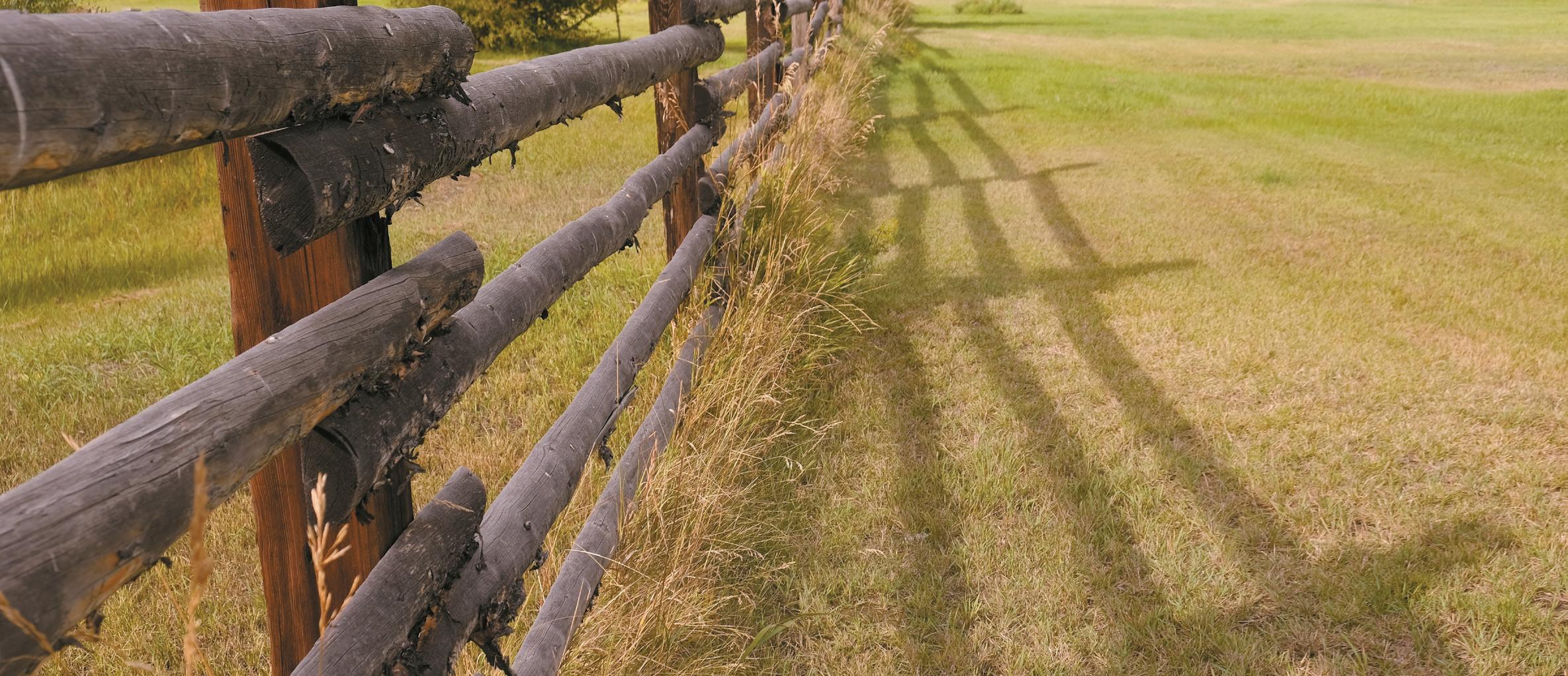
Montana Farmers Union’s membership and the types of family farms and ranches represented range greatly – from conventional to organic and everything in between. It’s truly a grassroots organization. One of my favorite things about working for MFU is getting to learn about all the innovative and cutting-edge practices that our members all over the state are implementing to help make their farms be the best possible. It’s clear that our members and family farmers are striving to steward the land and lay the foundation for future generations.
In this diversity of membership, we find strength.And it’s in this strength of diversity where we all challenge ourselves to learn something new, hear a new perspective, and see the many different avenues that family farm agriculture takes to make it work – no matter the type of agriculture you implement on your own farm.
At Montana Farmers Union, we strive to support the innovation we see in the fields and the diversity of our membership with educational programming, conferences, speakers, and membership networking opportunities.You might find yourself wondering, well how do all these speakers and programs get planned? What’s the “secret?” Well, all these opportunities are driven by the ideas and direction of our grassroots committees.
Montana Farmers Union offers many opportunities to serve on a committee where you can make your voice heard.
Our Resolutions Committee reviews our policy book each year prior to convention to ensure that it is still meeting the needs of our membership as we confront the ever-changing field of agriculture and family farm policies and legislation at the state and federal levels.
Our Women’s Conference Committee puts together the programming, speakers, and ideas that have helped make our Women’s Conferences the highly successful events that they are.
Our Convention Planning Committee, like the Women’s Conference Committee, helps drive the programming of the Annual Convention where members from across the state gather to learn and network and further support the future of family farm agriculture.
You might be wondering,“Well how much time does it take to be a part of an MFU member committee?” And the great news is: It’s minimal! We know producers’ time is valuable and limited – but is so incredibly important in driving our grassroots organization. Our committee members join meetings virtually a few times throughout the year (Policy Committee meets a bit more regularly leading up to convention) leading up to the respective events that their committee is tasked with. Our committees are run by MFU staff who handle the notes, take down ideas, and do our best to implement the ideas of the membership.And, if you plan to join us in person at the event and actively participate in committee meetings, we cover your registration costs of the event.
So, if you have an idea or see a need for one of our upcoming events, I challenge you to join one of our committees.Whether it’s your first year as a member or your twentieth on our committees, you’ll meet new members and reconnect with friends in community. We can take your ideas and make them reality (as best we can!).And you, as the member, truly drive the grassroots organization that is Montana Farmers Union.




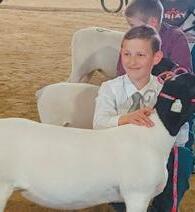


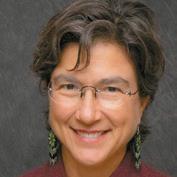

Mamie Hertel grew up on a farm and ranch in Moore, where she is the fifth generation of her family‘s operation. She served as the National FFA Central Region Vice President in 2019-2020 and graduated from Texas A&M University with a degree in Agricultural Communications and Journalism in 2023. Currently, she works for Texas A&M AgriLife Marketing and Communications.
Marsha Goetting, Ph.D., is a Professor and Extension Family Economics Specialist at Montana State University in Bozeman. During the COVID years 2020 through 2022 her virtual seminars reached more than 13,450 Montanans and another 7,140 during 2023. She received the Iowa State University Alumni Achievement Award in 2020 and the AARP Community Partner Award in 2021. In 2023 she received the Distinguished Service Ruby Award from Epsilon Sigma Phi, an Extension Honorary. Dr. Goetting is a member of the Montana Alzheimer’s and Related Dementia’s Coalition and has been appointed to the Montana Supreme Court Commission on Continuing Legal Education.
Eric Hinebauch has been an agent with Farmers Union Insurance since 2011. He works from his office in Great Falls, and has expanded his agency by adding an office in East Helena in 2021. He brings extensive experience and knowledge to his role, particularly in safeguarding farm and ranch operations in the state. With deep roots in Montana‘s agricultural community – having grown up on a farm near Chinook, where his family still farms today – he has firsthand insights into the unique insurance needs of farmers and ranchers. Believing that strong communities are essential to the Montana way of life, he is active in his community and involved in local politics in Great Falls.
John McNamara is an 11-year-old who spends his days expanding his Dorper sheep herd, growing dahlias, raising exotic pheasants, sewing, and tending to his prize arachnid and reptile collection on his family farm near Plains. John is an advocate for 4-H and Montana Farmers Union. He loves sharing his love for plants, animals, and fashion with his friends.




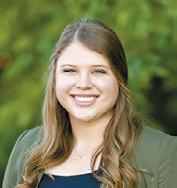
Sherry Devlin worked as a newspaper journalist for 40 years, the last 30 years of which were as a reporter and editor for the Missoulian newspaper in Missoula. Since retiring from the newspaper several years ago, she has worked as a freelance writer and editor, and enjoyed hiking Montana‘s mountains, floating the rivers and tending tomatoes, artichokes, peppers and rhubarb with her granddaughter.

Nick Gevock has been engaged in wildlife and lands conservation issues for over two decades in Montana. He worked as a reporter in Bozeman and Butte for longer than 11 years, covering local government, natural resources, agriculture, and outdoor recreation. He moved into policy work over a decade ago, serving as the conservation director for the Montana Wildlife Federation, where he worked on key wildlife and lands issues on the local, state, and federal level. Currently he serves as a Field Organizing Strategist for Northern Rockies Wildlands and Wildlife for the Sierra Club.
Jasmine Krotkov is a Master Gardener with decades of experience designing and installing chinook zone gardens. She grows fruits and vegetables at elevation, where the growing season is short and the deer are hungry. She has taken time out from gardening to work as an advocate publicly for peace and a clean and healthful environment.
Tracy McIntyre is a Eureka native who understands the importance of economic development in Montana’s communities. She is currently executive director of the Montana Cooperative Development Center.
Paul Nugent specializes in agriculture engineering. Along with other agriculture faculty, Paul will help to create precision ag courses forMSUstudents and aid in the development of a future minor.

Md Sayemul Islam, a graduate in Agricultural Economics from Bangladesh Agricultural University in 2022, is currently pursuing an MS in Applied Economics at Montana State University. Engaged in cutting-edge research, he is exploring the Economics of Precision Agriculture in Montana. His focus lies in understanding the economic implications and benefits of precision farming techniques, contributing to the advancement of sustainable and efficient agricultural practices in the region.
Alice Miller is a press relations specialist with Montana Farmers Union. Originally from the East Coast, she roamed The West as a newspaper reporter before settling down on her husband’s Hi-Line family farm and ranch.

Rachel Prevost is the Membership Services and Government Affairs Director at Montana Farmers Union. Prevost grew up on her family’s farm and ranch in Northeastern Montana and was a 10-year member of 4-H and 5-year member of Montana FFA. Prevost studied Political Science, Communication Studies, and Public Relations for her undergraduate degrees and cares deeply about the vitality of our rural communities and the sustainability of family farms for generations to come.


